


 |
July 6, 2009: The Paul Potts Concert in Dallas |
 |
June 17-21, 2009: A Trip to New Mexico |
 |
Return to Index for 2009 |
Introduction
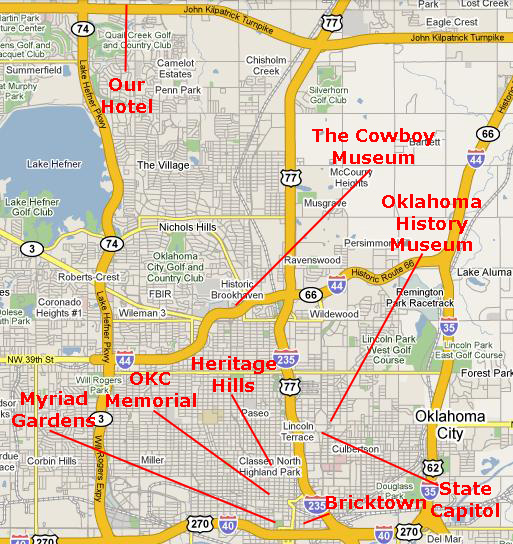 |
At left is a high-level map of the Oklahoma City area that will orient you generally to the attractions that we saw over the weekend.
As you can see, our hotel was a little out-of-the-way, but that was good for keeping cost down. Friday evening, we had dinner in Bricktown and went to see the OKC Memorial at night. On Saturday, we visited the Myriad Gardens, had lunch in and walked around Heritage Hills, visited the State Capitol and the Oklahoma History Center. On Sunday, before heading back to Dallas, we spent the morning at the Cowboy and Western Heritage Museum.
June 26: The Drive to Oklahoma City
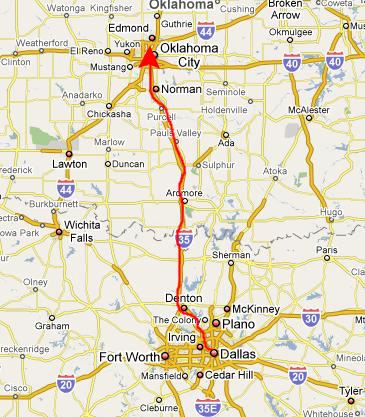 |
Steve and Mario had found a La Quinta on the north side of the city- in a new area just being built up called Quail Pointe (everything seems to be more upscale any time there is an "e" at the end of "Point.") Usually, here in the photo album, I include aerial views of hotels and stuff, but in this case, the entire area is so new that neither the La Quinta nor any of the restaurants and shopping anywhere around appear; I think there is a corner gas station and that is about it. But if you are curious, the hotel was near the intersection of North May Street and the new John Kilpatrick Turnpike; this intersection is a couple of miles west of US 77.
The hotel was pretty nice. We got checked in and headed down to the city to visit Bricktown.
June 26: Bricktown: Oklahoma City's Riverwalk
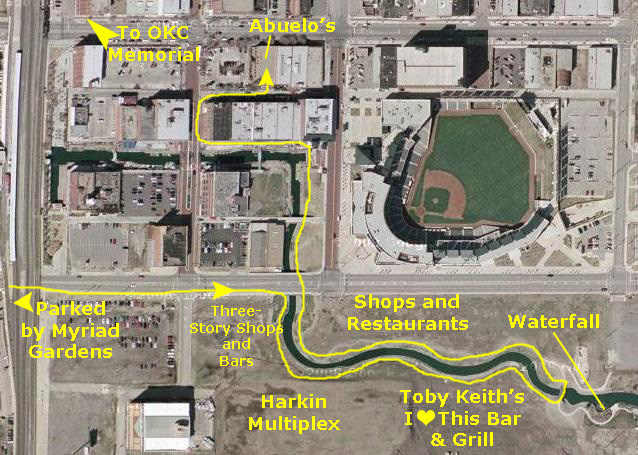 |
Bricktown, which takes its name from the old ballpark that used to be there (and which, as you can see in the aerial view at right, has been replaced by a new one), is Oklahoma City's answer to San Antonio's Riverwalk. Unlike in San Antonio, the "river" along which the walkways and restaurants and hotels and other businesses are located is entirely artificial, although there is a small creek south of I-40. The "river" really doesn't flow anywhere at all; actually, it doesn't "flow" at all, being just a long, thin, winding artificial pond, albeit a pond big enough to sport cruise barges about the same size as those on the San Antonio River. I would guess that the "river" averages about fifty feet across- maybe a bit more.
There are walkways on either side of the river, and some pedestrian bridges across it. The river goes underneath Reno Avenue, but that is the only street that crosses it (unlike in San Antonio, where the San Antonio River and the Riverwalk that lines it goes underneath a great many downtown streets on its way through the city). When we got to the river, we descended from street level to the walkways, and found ourselves alongside a building that contained a number of shops, bars and restaurants. The walkway went south along the south side of the waterway, in front of the Harkins Theatre multiplex. You can see a couple of shots we took of each other at this point here and here.
|
Along Oklahoma City's Bricktown Riverwalk |
We crossed over to the north side of the waterway, and then headed north to the older part of the system and the northwest end of the waterway. There, we went back up to street level to have dinner at Abuelo's restaurant.
June 26: The Oklahoma City National Memorial
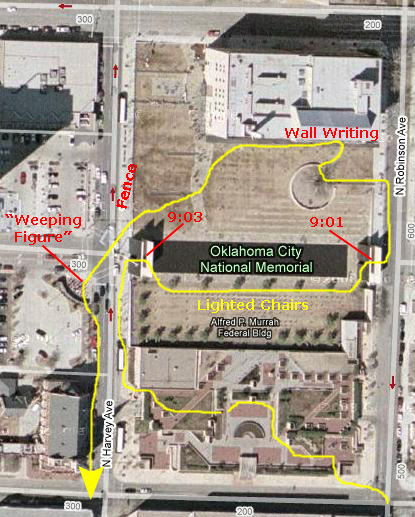 |
We continued walking through downtown until we came to the southeast corner of the OKC Memorial, which covers about four acres.
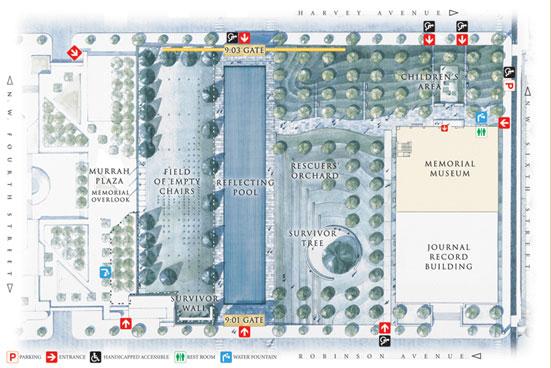
The Task Force became the Oklahoma City National Memorial Foundation, and it drew members from the families who lost loved ones in the bombing, survivors of the bombing, rescue workers and volunteers who participated in the rescue and recovery efforts and community volunteers. The first task was to solicit design concepts for the outdoor memorial; a competition resulted in 624 entries from all 50 states and 23 countries. The final design was announced in July 1997.
In 1997, the nacent Memorial was made a unit of the National Park System, and monies were appropriated by the Congress to begin work on the Memorial. These amounts were matched by the State of Oklahoma, and this total was then trebled through private donations. The outdoor symbolic Memorial was dedicated on April 19, 2000, the fifth anniversary of the bombing; the Memorial Museum was dedicated a year later.
The Outdoor Symbolic Memorial is a 3.3 acre site featuring 168 glass‑based chairs (representing those killed), the Gates of Time at either end of a 318-foot Reflecting Pool (one shows the time one minute before the explosion and the other shows the time one minute afterward), the Survivor Chapel, the Rescuers’ Orchard, a Children’s Area and the Survivor Tree. A small part of the original wall of the Murrah Federal Building was left, and it became the Survivor Wall.
When we reached the Memorial Overlook, we stopped at an interesting aerodynamic moving sculpture before climbing up onto the overlook where we could see the entire field of commemorative chairs.
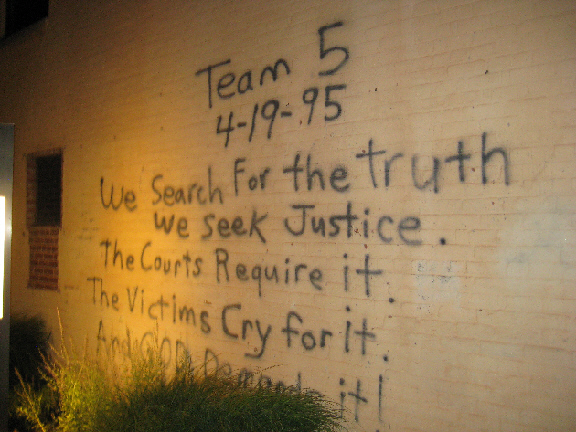 |
A rescue worker originally painted this message on the wall during search and recovery efforts in April, 1995. The building was a functioning office building when the bomb exploded across the street. Ceilings collapsed, walls fell in and glass shards flew throughout the building. Hundreds of people were injured, many critically. Fortunately, no one was killed inside this building. When the Memorial was being built, this building was rehabilitated and stabilized, and then added onto to form the Museum. This south wall was left untouched, except for stabilization of the many cracks and fissures and the application of a protective seal to prevent damage to the inscription and the wall itself.
We continued walking around the west side of the Memorial, past the Fence and back south. Just across the street from the Gate of Time for 9:03AM, a building and church belonging to the Catholic Diocese of Oklahoma City were also severely damaged. The Diocesan building had to be demolished, but part of the church was saved. The Diocese built its own small memorial, commemorating the injuries suffered by persons inside that building.
When we were done at the Oklahoma City Memorial, we walked back through town to the area of the Myriad Gardens. There, we had to walk around the Convention Center to get to where the car was parked, and on the way, found a large buffalo sculpture (commemorating the Oklahoma City Rotary Club, apparently) and I took Fred's picture with it. Then we picked up the car and headed back to the La Quinta.
June 27: The Myriad Botanical Garden
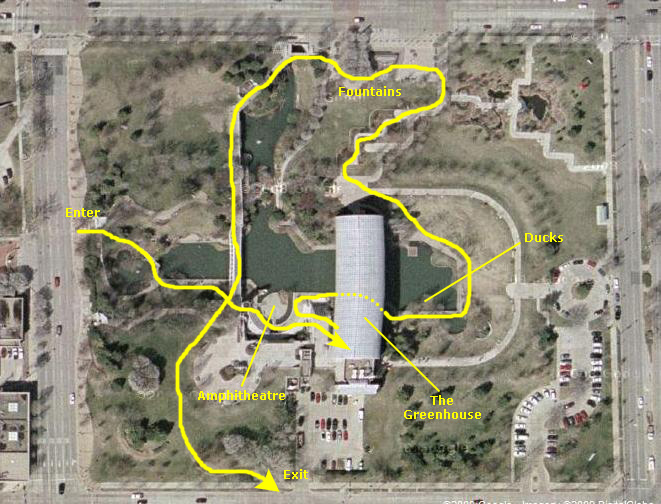 Aerial View of Myriad Gardens |
The greenhouse is very unusual; it is a long, tubular structure lying horizontally on the ground. It spans a small lagoon, resting on supports at either end. Fred and I had never seen anything quite like it the first time we were here, and Steve and Mario were duly impressed. Particularly in juxtaposition with the downtown skyscrapers, it looks very futuristic, and is an excellend backdrop for pictures. Below are thumbnails for two pictures of us with the greenhouse and downtown Oklahoma City as a backdrop; click on them to view:
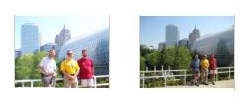
|
There are other interesting aspects to the Myriad which are quite unlike the Dallas Arboretum. There is an enclosed bridge across the lagoon that leads from one side of the gardens to the other, an amphitheatre and various small exhibits scattered around the entrance plaza. Below are thumbnail images for pictures of some of these features; click on the thumbnails to view the pictures:

|
We went inside the greenhouse, and Fred was about ready to plunk down $24 for the four of us when Steve suggested that we try our memberships to the Dallas Arboretum to see if they would get us a discount. Discount? They got us in for free! Many thanks to Steve for the suggestion! So we got our tickets and went inside.
Inside the greenhouse, you first encounter an entry/exhibit area, and there are some tropical birds kept in cages there. Then you enter the greenhouse proper, and you are inside the long, tubular structure. On the main floor of the structure, you can walk through the various plants to the far end, and it much like any other greenhouse we have been in, save for the curved glass sides of the structure. When you get to the far end, though, there are stairs up to the skybridge that brings you back through the greenhouse, but this time up in the canopy where the taller plants reach. Finally, when you get back to the end of the structure where you entered, the stairs down lead through a series of waterfalls to bring you back to your starting point. One other thing to mention is that, like the Dallas Arboretum, the Myriad apparently has "themed" structures that provide an interesting backdrop to the plants, and in the Myriad the "theme" was a South Seas pirate one. There was a small pirate ship and a couple of South Seas-type structures ideal for kids to play in and climb on.
We took a lot of pictures here in the greenhouse, which is to be expected given the interest that both Fred and Steve have in all things horticultural. I've selected the best of them to include here, and I'll group them according to the main features of the greenhouse- the plants themselves, the stairway area, the skybridge, the waterfalls and artificial brooks and the themed structures. I'll also include as the second group all of the candid shots that we took of each other and of the greenhouse itself as we walked around. Each of these groups will have its own section below, consisting of thumbnail images that you can click on to view the full-size pictures.
Plants, Flowers, and Ourselves in the Myriad Botanical Garden
|
To view the slideshow, just click on the image at left and I will open the slideshow in a new window. In the slideshow, you can use the little arrows in the lower corners of each image to move from one to the next, and the index numbers in the upper left of each image will tell you where you are in the series. When you are finished looking at the pictures, just close the popup window.
The "Desert Stairway" in the Myriad Botanical Garden
At the far end of the greenhouse, some sets of stairs take you up to the level of the skybridge. From the top of the stairs, you can get an excellent view of almost the
entire greenhouse interior.
This area of the greenhouse is done in cacti, succulents and other plants that thrive in higher temperatures and more arid conditions; the area is quite a contrast with the area near the entry where the waterfalls are. So in the pictures whose thumbnails are below you will see a different sort of terrain; click on the thumbnails to view these pictures:

|
The "Skybridge" in the Myriad Botanical Garden
Once we climbed the stairs (and had a look out the north-facing circular window at the end of the greenhouse), we came out onto the skybridge, which was a walkway running the length of the greenhouse and suspended from the ceiling by cables. We stopped at the north end to take some pictures where you can see the skybridge; Steve took one of
Mario and I
and I took one of
the other guys.
Then Fred, Mario and I walked down to the south end of the bridge while Steve waited behind to take a
picture of us.
Greenhouse Decoration
As I said earlier, the Myriad greenhouse, like the Arboretum in Dallas, seems to have rotating decoration suiting the season; at this time, it was kid-oriented, fairy-tale stuff- like the pirate ship. Below are thumbnail images for some of the pictures we took of these decorative elements; you can click on them to view the full-size pictures:

|
The Waterfalls and Streams
Back at the south end of the greenhouse, the skybridge ended at some well-hidden stairs that led back down to the main floor of the green house, through the thick foliage and behind the largest of the waterfalls. As we descended the path and the stairs, we marveled at how well the large waterfall and the two small streams and waterfalls were integrated into the plants and trees; it was a very refreshing place to be. Below are some thumbnail images for some of the best photos we took here in the area of streams and waterfalls; click on them to view the full-size pictures:

|
|
Main Waterfall in Myriad Gardens Greenhouse |
In the other two, you can see two of the streams and smaller waterfalls that have been built here in the Myriad Gardens greenhouse; you can watch those movies using the two players below:
|
|
Outside the Greenhouse and Along the Lagoon
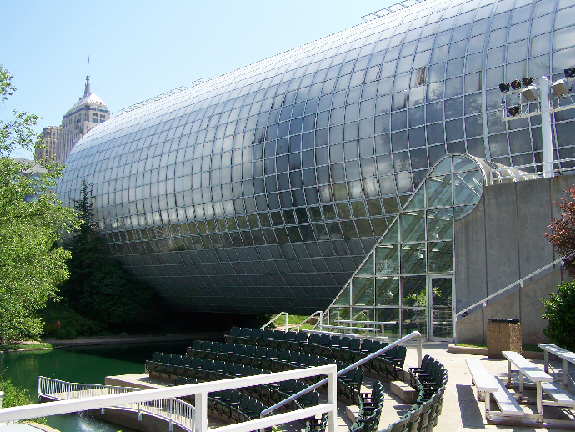 |
|
|
Then we followed the walkway underneath the greenhouse which is actually suspended over the lagoon, resting on supports at either end, as you can see more clearly here. Coming under the greenhouse we were on the shore of the eastern end of the lagoon, and could look back to get excellent views of the greenhouse and lagoon. The lagoon had a rotating fountain in the shape of a fanciful whale and also a couple of kinetic sculptures. Finally, underneath a grove of trees here beside the lagoon we found some of the local residents.
Myriad Gardens: North Side
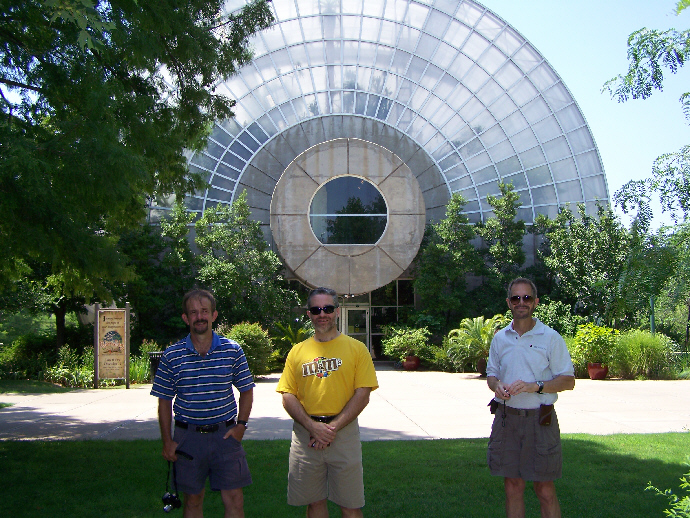 |
At this end of the property, there were some very nice gardens that we wandered through, and some of us took the opportunity to deal with the heat by sitting on one of the garden benches that we found along the walkways.
This end of the Myriad Gardens borders on downtown Oklahoma City, and there was a very nice fountain here where we spent some time and took some pictures. You can see two of the best of these if you click on the thumbnail images below:
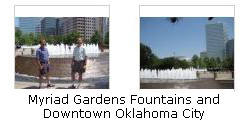
|
Our Visit to Myriad Gardens Ends
|
|
I also made a movie of the entire greenhouse and this end of the gardens, and you can watch that short movie using the movie player at left.
When we crossed back over the entry plaza walkway, we found a service pathway that led us due south and back to Reno Avenue where the car was parked. Just before we went over the crest of the hill and down to the street, Fred looked back at Myriad Gardens and Oklahoma City.
June 27: Lunch and a Tour of Heritage Hills
Lunch at Somewhere Else
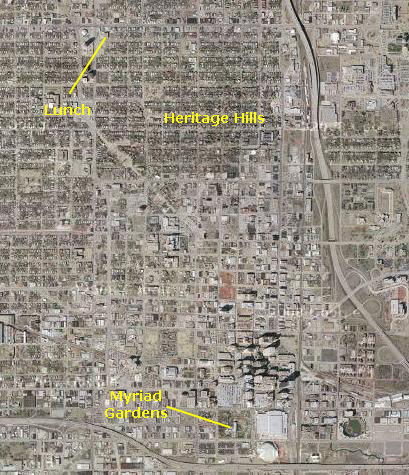 |
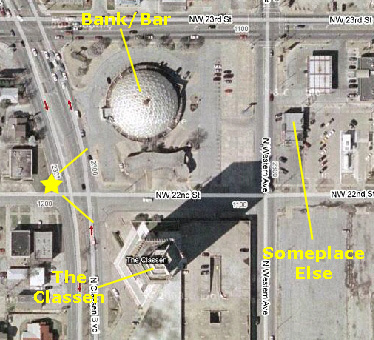
After we had our sandwiches and that very crowded local place, I walked across the parking lot west of the restaurant and around one of the more intriguing buildings I've seen lately.
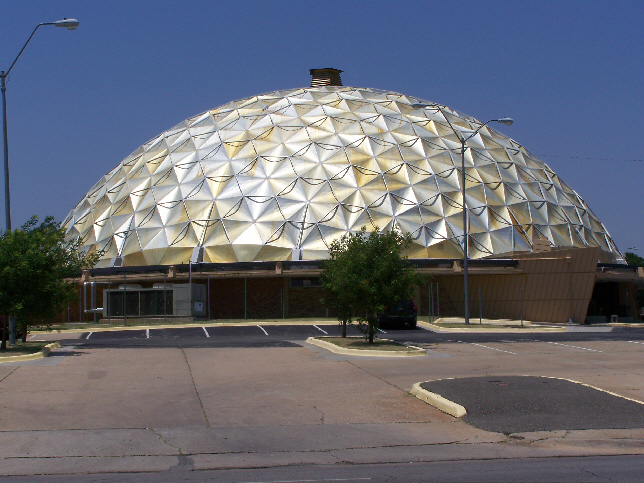 |
Just south of this interesting building was another, just as interesting, skyscraper. About twenty stories tall, by my guess, The Classen used to be an office building but it has been converted into apartments. This building, too, was very 1960s in its appearance, and the fact that it has the appearance of being built on stilts added to its interest. I am not sure I would want to live in it, but it probably has pretty amazing views in just about every direction, as there were no other tall buildings around- and downtown is three or four miles away.
After I'd taken my pictures, I rejoined the guys and we drove over to the middle of Heritage Hills.
The Overholser Mansion in Heritage Hills
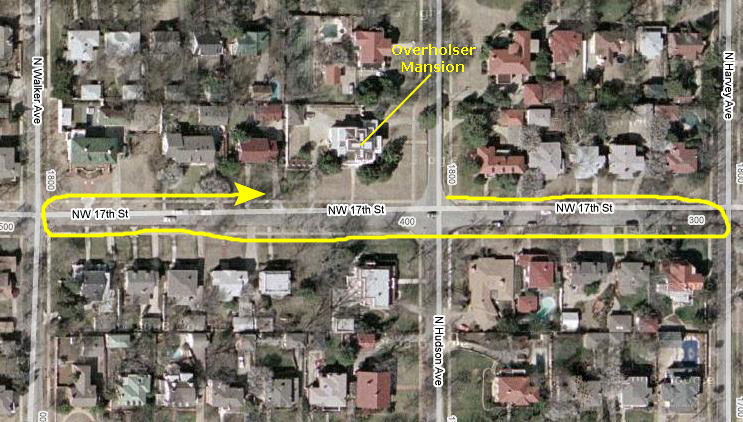 |
From their Internet Web site, we learned that the Henry Overholser Mansion stands as a tribute to one of Oklahoma City’s truly remarkable families. The three‑story home retains its original furnishings and fixtures, which provides a unique experience to the public, as visitors are able to enter another time and see the Mansion as the Overholser family did. And the historical marker in front said that this was the first great house in Heritage Hills, built in 1903.
Mr. Overholser arrived in Oklahoma City in 1889 and was involved with nearly every aspect of the city’s growth until his death in 1915. He built over 35 buildings, including two opera houses, the United States Courthouse, and the State Fairgrounds. He was the founding president of the Board of Trade, today known as the Chamber of Commerce, and was involved with the County Commission, the first water works project, and the first trolley car system.
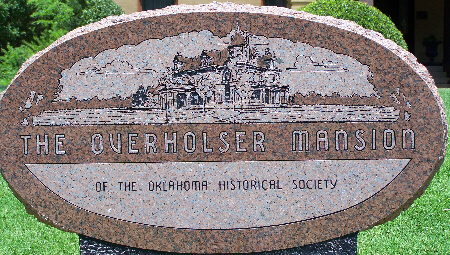 |
There is not much that I can say about the mansion itself, not having had the chance to go inside it, so I will just put thumbnails below for the best of all the pictures we took while walking around the property. You can click on these thumbnails to view the full-size pictures:

|
The Homes of Heritage Hills
Heritage Hills is a really beautiful area, and we spent some time just walking up and down the street where the Overholser Mansion was located, and we took some pictures of some of the interesting homes. I don't know much about architectural styles or anything at all about the history of some of the homes, but you might want to have a look at some of them. Just click on the thumbnail images below to see the full-size pictures of some of these lovely homes:

|
June 27: A Visit to the Oklahoma State Capitol
Our next stop today was going to be the Oklahoma State Capitol.
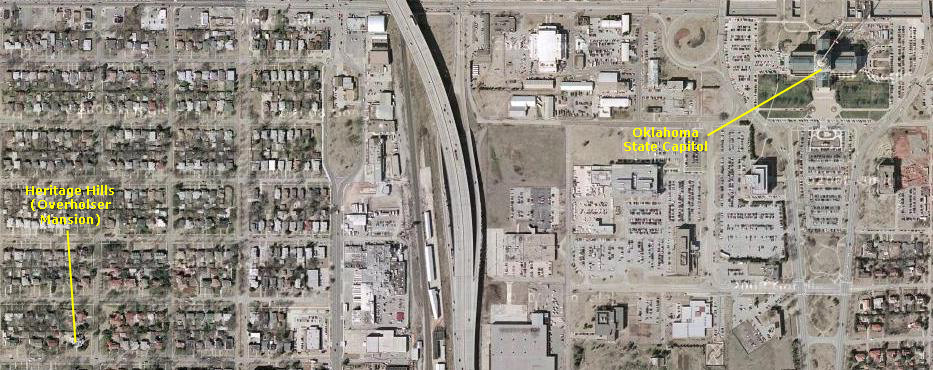
Getting there was pretty easy- just a short drive a little further northeast on the other side of the expressway. It took us only five minutes to get there, but twice that to settle on a place to park. (Even though it was Saturday, I didn't think that parking in a space marked "Reserved: Lt. Governor" was a good idea.) One interesting view before we actually arrived was the southern approach to the capitol, what with the oil derrick and all.
On the Plaza in Front of the Oklahoma State Capitol Building
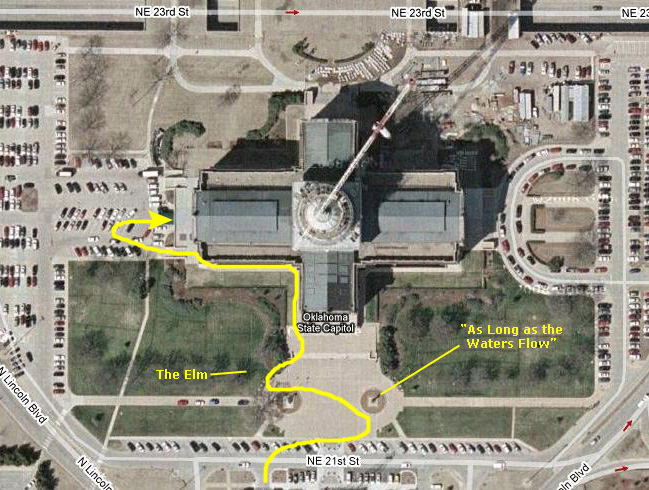 |
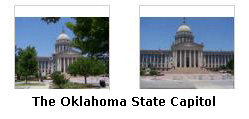
|
There were two statues in front of the capitol. One was entitled "As Long as the Waters Flow" and was executed by Allan Houser. We would come to find later during our tour of the State Museum that Houser was a Chiricahua Apache widely known for his sculptures and artwork. He was born near Apache, Oklahoma, on June 30, 1914, the son of Sam and Blossom Haozous. This particular work was commissioned by the State of Oklahoma and the State Arts Council of Oklahoma, and was dedicated on June 4, 1989. Allan Houser died in 1994 after producing a huge volume of work; he is probably the most renowned Native American painter and sculptor. You can see a close-up view of the top of the sculpture here. As it turned out, Fred and I have seen other pieces of his; there are a couple of them at the Gilcrease Museum in Tulsa where we went a few years ago.
The other statue is entitled "Rider of the Range" and was executed by Constance Whitney Warren. It is an intricately detailed sculpture of a bucking bronco and a steadfast cowboy in wool chaps and was the first sculpture installed on the capitol grounds. The sculpture "represents Oklahoma history as seen through the eyes of the cowboy that rode across the land on his trusty steed."
Another sculpture sits atop the dome of the capitol building; it is called "The Guardian" and is 22 feet high. The bronze sculpture was executed, oddly enough, by an Oklahoma State Senator- Enoch Kelly Haney. At the time he was elected to the State Senate, Haney was a principal Chief of the Seminole Nation; his design was selected from the 22 submitted by Native American artists. The sculpture was reputedly modeled after Haney's own relatives; it took 10 months to complete, weighs 4,000 pounds, and was erected on June 7, 2002.
|
Off to the side of the plaza I noticed a bronze marker bronze marker underneath a tree. The inscription was "Washington first took command of the American Army under the grandparent of this elm at Cambridge, Mass. July 3, 1775." The tree and marker were, it said, "raised and presented by Maryland D.A.R, marked by Oklahoma D.A.R., this tree is planted as part of the 200th anniversary of the birth of George Washington. 1732-1932."

|
Finishing up on the plaza, we got some directions from a passerby and walked around to the west side of the building, descended to the sub-plaza level, and found the capitol visitor entrance.
Inside the Oklahoma State Capitol Building: Our Self-Guided Tour
When we entered the basement level of the capitol through the visitor's entrance, we were given a booklet that laid out a self-guided tour that we could take. We decided to follow the tour as closely as we could. When I read the first part of the tour booklet, I thought that what I might do would be to take you on the tour with us, providing our own pictures of the building features and artwork that were mentioned. With this in mind, I planned to photograph each mentioned piece of art and each mentioned building aspect. This plan quickly fell apart.
The very first piece of artwork mentioned turned out to be a blank space on a wall with a little paper image of the artwork and an explanation that it was currently on loan outside the building. I thought that I could just take a picture of the picture of the artwork and that you'd never know the difference, but when I saw how the pictures turned out, that plan, too, proved unworkable. Furthermore, many of the pieces of art were not lit very well, and when I tried to use the flash, I got lots of glare. Others, such as some of the artwork close to the ceiling, were too far away for good pictures- even with a zoom. As for some of the building features (such as the House and Senate visitor's galleries), we found many of them to be inaccessible (this being a Saturday). So, what to do?
I don't want you to miss out on the art and architecture of this, the most beautiful state capitol I have ever been in (FL, NC, TX, IL, NY and now OK), and so I have settled on a plan. I'll describe our tour floor by floor, and tell you about the art we did see and the building features that were mentioned in the booklet. Where we have an acceptable picture for something, I'll use that. Where we don't, I and you will fortunately be rescued by an excellent Internet Web site that describes the Art of the Oklahoma State Capitol. For the pictures we didn't get, I'll link you to a particular page on that site. These pages will pop up in a new window, just like the regular pictures. You can have a look and read about the artwork, and then just close the pop-up window to continue on the tour. Just be aware that I deserve no credit for the artwork descriptions; all of that comes from that quite excellent Web site.
So let's begin your tour. First, let me tell you a bit about the history of the Oklahoma Capitol Building, and make some general comments about the paintings and sculptures that adorn it.
The Oklahoma State Capitol Building: Introduction
The primary building material is white Indiana limestone with a base of pink and black granite extending to the top of the 1st floor. The pink granite is from near Troy in Johnston County in southeastern Oklahoma. The black granite is from Cold Springs in Jackson County in the southwestern part of the state. Each of the state's 77 counties donated materials to be used in the construction. Containing approximately 650 rooms, the Capitol occupies 11 acres of floor space.
The State Capitol is rich with more than 100 works of art, each with its unique story of diversity and tradition. From monumental bronze sculptures that adorn its plaza, to magnificent murals, portraits and paintings that bring vibrancy to its interior, the art housed in the State Capitol has created beauty and interest for the thousands of tourists and Oklahoma school children to come to visit the Capitol each year.
On our right we passed some double glass doors- the entry to the Senate Visitor's Gallery. Unfortunately, the gallery was closed today. It would have been interesting to see the earlier remodeling efforts that "modernized" the historic chamber, concealing many treasures of the original design. In 1993, Oklahoma architect Paul Meyer headed a $1.5 million restoration effort (as much as the original construction of the whole building cost), based on original specifications and blueprints. With the removal of paneling and a dropped ceiling, elegant architectural details were revealed.
So we passed by the doors to the gallery and continued along the hall. Up to our right there was a lunette, or semi-circular painting above the Senate Gallery. Called
"Oklahoma Black Gold,"
it it by Enid artist, Jeff Dodd, and recognizes the importance of the oil and gas industry in Oklahoma. If you would like to read a description of the painting and learn more about the artist, please click
here.
The last painting we saw in this section of the hall was
"Tallgrass Prairie"
by Wayne Cooper of Depew.
Now I turned to continue down the corridor to the west, and facing me on the west wall was
"Game Birds at Glass Mountain"
by Harold Holden of Kremlin. When we turned the corner to the south, we were on the House side of the Capitol, and we passed the double doors leading to the House of Representatives Gallery. Like the Senate Gallery, it was closed today.
In fact, visitors to the House often notice that the Oklahoma House Chamber is much more elaborate than the Oklahoma Senate. In 1999, Meyer was again called upon for a massive restoration project. Early legislators would be amazed because some of the work involved adding features that were originally planned for the chamber but never realized due to the cost involved.
Sixteen windows along the north and south walls were uncovered for the first time in 30 years. The
stained glass panels
in the ceiling were recreated based on fragments found in the basement. More than 140 gallons of paint were needed to restore and refresh the color scheme, including 20 gallons of gold paint for decorate elements in the ceiling and around the room. Lamps reproduced from a surviving World War I-era original were installed. the old-fashioned oscillating fans are original and still work, though they are seldom needed with contemporary air conditioning. Each fan has a tiny replica of the state seal in the center of its grille.
Once past the doors for the House Gallery, we could see another lunette,
"We Belong to the Land".
Like its companion across the Rotunda, it was painted by Jeff Dodd. It salutes the state's agricultural heritage.
We continued around the hall, passing
"Elk Herd in the Wichita Mountains"
by Barbara Vaupel of Henryetta.
Before we take the stairs down to the 4th floor, I want to include a selection of some of the pictures we were actually able to take from here on the 5th floor. Not all of them turned out perfectly, but if you will click on the thumbnail images below, you can have a look at them:
Most of the artwork in the Capitol has been added in recent years the
painting above the Grand Staircase
is an exception. Commissioned in 1927 by Frank Phillips of Phillips Petroleum,
"Pro Patria,"
meaning "for the fatherland," was created in memory and honor of the Oklahomans who served in World War I. Painted by Gilbert White of Paris, France, it consists of three large murals and a lunette. The lunette and central painting (seen in the picture of the Grand Staircase entrance earlier), the only elements on public view, contain the words, "Pro Patria," and show a soldier bidding good-bye to his family. The other two murals contain the names of the 2,735 Oklahomans who died in the conflict.
Originally, the Capitol was topped with a relatively flat roof. Inside, the illusion of a dome was created by an inverted shallow bowl-shaped construction decorated with a painted plaster state seal. In 2001, workers began dismantling the old ceiling and roof in preparation for the installation of a true dome. Two million pounds of brick and concrete had to be removed. Because the original plans had called for a dome, the existing building was already reinforced to carry the load of the approximately five million-pound structure. Construction was completed in 2002.
The exterior of the dome is made of pre-cast concrete elements ranging from small suitcase- to sedan-sized pieces. The distance from the state seal on the first floor of the building to the stained-glass seal in the top of the dome is 190 feet. The dome's diameter is 80 feet. The color scheme for the interior of the dome was inspired by the gaillardia or Indian blanket, the state wildflower.
The southwest mural,
"Discovery and Exploration, 1541‑1820,"
features Coronado and his men, grass huts of the Wichita Indians, French fur traders of the 1700s, bison, Nordic runes and an early U.S. Army expedition. Going clockwise, the next mural is
"Frontier Trade, 1790‑1830,"
depicting trade with Osage hunters, keelboats and flatboats, early mission school activities and commercial enterprises such as sawmills and salt making. The next mural is
"Indian Immigration from 1820‑1885."
This painting shows the emotional and physical challenges American Indians faced with relocation, the encroachment on the native peoples in Oklahoma and the removal on the Trail of Tears. The final mural in the series,
"Non‑Indian Settlement, 1870‑1906,"
tells the story of the sttate's land runs of 1889 and 1893, including the forced sale by the Five Civilized Tribes of "surplus lands." Also pictured are a half-dugout and a sod house, both of which were common types of pioneer dwellings.
While we all took some picures of these murals, they really only turned out well in the movie that you saw earlier. But of the photos we did take, Fred's series turned out the best, and you can look at them by clicking on the thumbnail images below:
Heading back into the Rotunda, on the east side of the archway was a painting of songwriter and folk musician
Woody Guthrie
by Charles Banks Wilson. We continued on around the Rotunda, and came to the next painting of
Will Rogers.
Rogers, a Cherokee Indian, was a journalist, humorist, actor and goodwill ambassador to th eworld for the United States in the early part of the 20th century; you can see our picture of this painting
here.
In the east archway we found portraits of aviator and inventor
Wiley Post
by Mike Wimmer and a Mitsuno Ishii Reedy painting of
Ada Lois Sipuel Fisher.
Late in her life, Fisher, a lawyer, administrator and civil rights activist, was appointed to the Oklahoma University Board of Regents, the same body that denied her access to the University years earlier, prompting the lawsuit that desegregated higher education in Oklahoma.
The final full-length portrait here in the Rotunda was that of
Jim Thorpe,
one of America's all-time greatest athletes. Thorpe, a Sac-Fox Indian, born in Prague, Oklahoma, won gold medals in both the pentathlon and decathlon in the 1912 Olympic Games.
"Ceremonial Transfer of the Louisiana Purchase in New Orleans, 1803"
"Nathaniel Pryor and Sam Houston at Three Forks"
"Mahongo at the Court of Charles X of France"
and
The bronze roundels here, representing Eastern Oklahoma Indians, are by Enoch Kelly Haney, a full-blood Seminole Creek Indian, a noted painter and sculptor and a former State Senator.
We turned left and, when we reached the middle of the hall, the guidebook had us take a quick detour down the north hall to see an etched glass mural by Marrilynn Adams, Danny Newsom and Gary Adams. There is no additional information on the piece that I can find, but the guidebook said that we should look carefully at the signatures on the piece. Marrilynn chose to sign the piece as "Marilyn," because of the difficulty of engraving so small.
In the northwest corner of the main corridor was another of the portraits painted by
Simmie Knox,
this one entitled
"Albert Comstock Hamlin 1881‑1912."
He was the first African American to serve in the Oklahoma legislature. To the left, there was a large landscape in which the Round Barn is featured prominently. This picture is entitled
"Arcadia Round‑Up"
and it was painted by Linda Tuma Robertson. I could not find any record of the painting or a better picture of it, so this admittedly fuzzy one will have to do. Interestingly, the Round Barn is actually an historical site in Arcadia, Oklahoma, and is apparently well-known in the state. It is now, it seems, a B&B, and if you are connected to the Internet and would like to learn more about it, you can click
here.
Next, we came to the
lobby of the House of Representatives.
Here, there were two works by Wayne Cooper entitled
"Dugout Soddy on the Prairie"
and
"Oklahoma City, April 29, 1889."
The flag on the wall was originally displayed in the House Chamber in the capitol in Guthrie. there is another set of Haney bronze medallions, these representing the tribes of Western Oklahoma, on either side of the House doors.
We now walked past the Grand Staircase again to the southeast corner of the floor. Here was the fourth and last in the Simmie Knox series, this one a portrait of
"Roscoe Dunjee 1883‑1965,"
a civil rights leader and journalist who founded the Oklahoma City newspaper, the "Black Dispatch." To the south of the Senate Lobby was the last painting we saw on this floor. It was Mike Wimmer's
"Fort Smith Conference, 1865".
Having come full-circle around this floor, we walked past the Senate Lobby again to the elevator and descended to the 2nd floor. (Because of the architecture of the House and Senate chambers, the Supreme Court and the staircase, there actually is no 3rd floor that is open to the public.)
Roman Nose State Park is about forty miles northwest of Oklahoma City north of the town of Watonga, and so Hurley's painting of
"Sunset at Roman Nose State Park"
was placed between the north and west archways. The oil town of Anadarko is almost exactly the same distance from Oklahoma City but to the southwest, and so the southwest pillar here in the rotunda displays Hurley's painting of
"A Storm Passing Northwest of Anadarko".
Finally, Oklahoma's Muddy Boggy Creek can be found about 100 miles southeast of Oklahoma City, oddly enough just about forty miles northeast of Fred's house in Van Alstyne- right on the Texas-Oklahoma border- and so the southeast pillar in the rotunda displays Hurley's painting of a
"Spring Morning Along the Muddy Boggy".
All of these paintings were truly outstanding, and neither the images of them from the Oklahoma Capitol Art website nor our own pictures of them really did them justice.
Even though the lighting made it hard, we did get some actual pictures of these paintings that are worth including here in the album. You might want to look at some of them and compare them with the images you've already seen; just click on the thumbnails below to do so:
After looking at the beautiful Hurley paintings, we walked over to the balustrade around the opening that looks down to the first floor. The
hand rail and balusters
are made of alabaster from the area around Alabaster Caverns. It was feared tht the alabaster would not stand up to constant public use but, after 90-plus years, it seems to have passed the test. The square pillars of the banister are made of Georgia marble as are the circles and squares in the floor. Standing here in the rotunda on the second floor, we couldn't help but photograph some views looking upwards through the atrium this time. One photograph Fred took looks northward and upward to the "Flight of Spirit" mural above the fifth floor archway, and you can see that picture
here.
He also took another photograph
looking up four floors to the dome,
capturing once again the beautiful decoration of the dome's interior. Finally, since we were only one floor above it, I took another picture of the State Seal of Oklahoma that is inlaid into the first floor, and you can see that picture
here.
Through the north arch, we could see the Court of Criminal Appeals, but we went through the west arch to the
lobby of the Supreme Court Chamber.
Along the south side of the hall were display cases that contained the original Oklahoma Constitution, information about the constitutional process and the Great Seal of the State of Oklahoma. One of the most interesting tidbits of information concerns the length of the Constitution. It ran to 110 pages, in fact. Compare that to the original four-page Constitution of the United States. Constitutional Convention members were thorough, including such minutiae as specifying that the flash point of kerosene used for lighting purposes should be 115 degrees! President Theodore Roosevelt was not impressed with the document and was quoted as saying his opinion of the Oklahoma Constitution was not fit to print!
We went back to the main corridor alongside the rotunda we found the painting
"First Coal Production at McAlester and the KATY Railroad"
by
Wayne Cooper.
You can see a larger view of this painting at left.
We turned the corner and on our right was the
Hall of Governors.
Busts of all of Oklahoma's Governors line the room. When we returned to the main hall, we came to a nine-foot-tall bronze edition of
"The Guardian,"
a replica of the 23-foot sculpture which tops the Capitol dome. The sculpture is by Enoch Kelly Haney. The sculpture represents no specific tribe but represents all Native American cultures. Haney used family members as models for the work and incorporated, among other features, his son william's eyes and his grandson Enoch's cheeks. And finally, just before taking the elevator down to the first floor, we stopped to admire another Wayne Cooper painting-
"The Magic of Petroleum".
On the northeast wall there was a current Oklahoma State Flag, the one revised by the Legislature in 1941 (shown at left). The Oklahoma state flag has an interesting history.
The first Oklahoma State Flag flew from 1911 - 1925. It is said that the flag began to fall into disfavor after the Russion Revolution in 1917. The Red flag and single white star began to be too closely associated with symbols of Communism.
In 1924, a contest was announced to create a new design for the flag, one that more uniquely represented the diversity of cultures in the state of Oklahoma. For the state with the largest Native American population, it is easy to see why the design submitted by Mrs. George Fluke, Jr. was chosen and officially adopted by the State Legislature on April 2, 1925.
This flag remained in use until 1941, when the design was revisited. The state name "OKLAHOMA" was ammended to the 1925 design and is displayed in white letters below the shield. This change was not popular in some circles as it was felt that the design of the Oklahoma State Flag was significantly unique without this reminder. I agree. If you are an Oklahoman, you would presumably be able to identify your flag without the state name. For those not already familiar with the flag, then it might be better not to have the state name, as this would prompt people to wonder which state's flag it was and perhaps go look it up- an aid to remembering in the future.
At the entry to the east hall we found two paintings. On the north was a painting of Mickey Mantle by Kenneth Wyatt and, opposite it, was a painting by Enoch Kelly Haney entitled
"The Earth and I Are One."
Steve also took a pretty good picture of this painting, and you can look at that picture
here.
Also on the first floor we found North and East Galleries curated by the Oklahoma Arts Council with rotating exhibits by Oklahoma artists. In the east hall, we were particularly impressed by the sculpture,
"Kate Barnard,"
by Sandra Van Zant of Talala. "Miss Kate" was one of the first women in America elected to statewide office (Commissioner of Charities and Corrections, 1907). She is known for her efforts in prison reform, child labor and mine safety reform. Here are
Mario and Miss Kate.
There were also other paintings and exhibits; since they rotate, there is no information about them on the Arts Council Web Site, but you can see a couple of examples
here
and
here.
The complete collection comprises more than 100 works of art by Oklahoma artists. We found many interesting paintings and sculptures currently on display, and we took a number of pictures. I have put thumbnail images for the best of these pictures below, and you can see the full-size images by clicking on those thumbnails:
June 27: A Visit to the Oklahoma History Center
There seems to be some difference in what this complex is called. Most references on the Internet, and the little brochure we got when we paid our admission call it the "Oklahoma History Center." Oddly enough, the Web Site itself internally refers to the complex as "The Oklahoma Museum of History," so I am not quite sure what name to use. I will use the shorter one here- the Oklahoma History Center.
Taken from the guidebook, we learn that:
"The History Center is a division of the Oklahoma Historical Society. In addition to participating in and fully supporting the overall mission of the OHS to preserve and perpetuate the history of Oklahoma and its people by collecting, interpreting and disseminating knowledge of Oklahoma and the Southwest, the museum collects, preserves and interprets the complete history of Oklahoma for everyone. The museum fulfills its mission through the application of the highest standards of collections care, the presentation of diverse in-house and traveling exhibits, and multi-disciplinary educational programs.
The Oklahoma Museum of History is also an affiliate of the Smithsonian Institute. Smithsonian Affiliations are among the most comprehensive forms of Smithsonian national outreach. Through Smithsonian Affiliations, young people, families and students are able to experience a piece of the Smithsonian--their national museum--through their own hometown museums.
An architectural masterpiece, a decade in the making, the Oklahoma History Center was designed by the firm of Beck Associates of Oklahoma City in collaboration with the firm Helmuth, Obata, and Kassabaum of St. Louis, Missouri. Haley Sharpe Design Limited of Washington, D.C and Leicester, Great Britain designed each of the five historic and interactive exhibits."
The museum is located on 18 acres across from the Capitol building and comprises an outside entry plaza, an interior entry hall, five major galleries, support offices and research facilities and, back outside, the Red River Journey, which offers visitors a walking tour of the Red River Valley featuring land forms, vegetation and important historical locations. The grounds also include an outdoor oilfield exhibit with drilling derricks, a portable derrick and machinery associated with Oklahoma oil explorations.
We wandered through the museum galleries in no particular order, and we didn't take all that many pictures. So really, just a minimum amount of narrative is required to explain the pictures. I'll just organize them into groups for the outside entry plaza, the interior entry hall, the five galleries and the Red River Journey.
Coming up to the entrance we came to the signature piece of sculpture here at the museum-
"Unconquered," by Allan Houser.
Allan Houser is the most recent in the long line of a Native American family that stretches back almost two centuries. The entire family is pretty amazing (there are lots of references and sites on the Internet devoted to the family history and the artistic endeavors of many of its members), but I won't recount it here. You might be interested, though, to read the
display sign
for this particular sculpture. Just outside the entrance to the museum was another large bronze sculpture,
"Monarch at Rest".
Unfortunately, when I took a picture of Fred by this sculpture, I didn't realize that I still had my camera set on "flourescent light," the setting I'd used inside the State Capitol. This setting, when used outdoors or in daylight, renders everything bluish. This piece was executed by Harold T. Holden of Enid, Oklahoma. Supposedly, the sculpture was somewhat larger than scale. After taking that picture, we went on into
the Oklahoma History Center.
When we entered the building and paid our admission, we found ourselves in the central, three-story atrium. Suspended from the ceiling at about the second floor level was a replica of one of Wiley Post's airplanes,
the Winnie Mae.
The Winnie Mae was purchased for twenty-two thousand dollars in June 1930 by oil man Florence C. ("F. C.") Hall of Chickasha and was named for his daughter. Two months later Wiley Post, Hall's personal pilot, utilized the plane to win a Los Angeles-to-Chicago air race. In June 1931 Post, accompanied by navigator Harold Gatty, piloted the Winnie Mae around the world in a record eight days, fifteen hours, and fifty-one minutes. Post subsequently acquired the airplane from Hall and flew it solo around the world in July 1933. His time was seven days, eighteen hours, and forty-nine and one-half minutes.
Post used the Winnie Mae to conduct high-altitude flights beginning in 1934. Speaking of high altitude, you can see a view of the Winnie Mae from the History Center's third floor balcony
here.
Since its construction prohibited cabin pressurization, he developed the first pressurized flight suit. On December 7, 1934, Post set an unofficial record by flying the craft to an estimated fifty thousand feet above Bartlesville. After four unsuccessful transcontinental flights through the substratosphere, the airplane was retired. Post's widow sold the Winnie Mae and its original instruments to the Smithsonian Institution in August 1935. At the beginning of the twenty-first century the Winnie Mae was on permanent exhibit at the Smithsonian's Udvar-Hazy Center at Washington Dulles International Airport, Chantilly, Virginia, with a full-sized replica at the Oklahoma History Center in Oklahoma City.
Looking left down the
hall past the Research Library
we could see the exit doors leading to the Red River Journey. Looking right, down the
hall of the Vose Family Wing,
we could see a number of displays of memorabilia from the Space Program, including
the Gemini 6 capsule
and other Oklahoma related space artifacts and information.
But, hey, if you're a music afficianado, and you are just bubbling over with curiousity as to what the other top nine songs were, and you're currently connected to the Internet, you can find out and even listen to them
here.
If you want to see some of the pictures we took in this gallery, just click on the thumbnail images below:
This was one of those galleries in museums that contains almost too much to assimilate. One could, if one were very interested in Indian cultures, spend a whole day just in this gallery, looking at each and every exhibit and reading and understanding the large volume of printed information that accompanied the artifacts and exhibit materials. We had only a half-hour or so for this gallery, but it was still immensely interesting.
If you want to see some of the pictures we took during our visit to the ONEOK Gallery, just click on the thumbnail images below:
The Inasmuch Gallery is an exploration of the breadth of Oklahoma's artistic achievements as well as the impact of an extremely diverse immigrant population. The gallery covers a broad range of subjects, including Oklahoma's entertainment value as a land of cowboys and Indians, its pioneering innovations in beroadcasting and the dramatic and unifying impact sports and sporting events have made on its communities. Included in the exhibits were "Voice, Vision and Vacuum Tubes," "Wild West Shows," "Sports," "Diversity," "Images of Oklahoma" and "Culture and the Arts."
This exhibit hall was full of all kinds of interesting exhibits, most of them focusing on technology and culture- from art (notice the pink Volkswagen Beetle covered with buffalo), to broadcasting (see the early color television camera from one of the Gaylord broadcasting stations) and to culture (the kid's room from the 1970s). If you will click on the thumbnail images below, you can have a look at some of the pictures I took here in the Inasmuch Gallery:
Mr. Noble regularly flew in and out of Ardmore, Oklahoma to manage his businesses. This practice allowed him to observe from a different perspective the significant erosion and other effects resulting from poor farming practices in Oklahoma and north Texas. He regarded the land as essential to the future growth, prosperity and security of our country. Accordingly, the early efforts of the Foundation focused on educating and encouraging area farmers and ranchers to be mindful of land stewardship and resource conservation.
Lloyd Noble died unexpectedly of a heart attack at age 53 on Valentine's Day, 1950. He left a substantial part of his estate to the Foundation. The Foundation continues Mr. Noble's vision today — influencing agriculture by exploring and improving production agriculture techniques and advancing plant science through research and discovery. Similar to Mr. Noble's other endeavors, the Foundation's influence is no longer limited to southern Oklahoma but stretches worldwide. The Foundation's operations are conducted through three operating divisions — Agricultural, Plant Biology and Forage Improvement.
This foundation endowed the Noble Gallery here at the Oklahoma History Center. It contains exhibits on agriculture-related topics (the Oklahoma land runs, farms and ranches, urban frontiers and weather) but has also branched out into related areas (quilts, government and politics, law and order, fashions and education). Through artificats, images and first-hand accounts of the participants, one can relive the lives of those brave souls who settled the Great Plains and turned homesteads into farms and cities. Noble felt that it was their curvival of, and adaptation to, the extremes of weather, economics and politics that enabled them to create the state of Oklahoma.
There were other, more eclectic exhibits as well. One was a restored
1951 "Bullet Nose" Studebaker
(price then: $1600), placed here in the exhibit because it was originally purchased from and Oklahoma City dealership.
Another interesting item, the recreation of a 1950s lunch counter, was part of an exhibit on the culture of Oklahoma in mid-century. You can have a look at the most telling part of that exhibit
here.
The Oklahoma History Center Red River Journey is a relaxing 1/4-mile walking tour that replicates the Red River Valley along Oklahoma’s southern boundary. A wonderful exploration of the state’s historical landmarks, the Red River Journey offers visitors a sample of Oklahoma’s diverse terrains as well as its indigenous trees, flowers and plants. Below, taken from the History Center guidebook, is a diagram of the walk:
I won't attempt to mark on the diagram where each and every picture I'd like to show you was taken; that wouldn't add much to your enjoyment of them. When we came out of the south entrance of the museum, we stopped at the fountain there (take a look at the pictures we took of us and it
here
and
here).
Then we walked along the short trail from that point to its eastern end before returning to the car. We stopped at each
sculpture,
and took pictures of many of them. Below are some thumbnail images for the sculptures we saw, and alongside each is a description of it. Click on the thumbnails to view the sculptures:
Well, we were done with our sightseeing for the day, so we returned to the La Quinta and hung out by the pool for a while, and then went to dinner at a nearby restaurant- The Interurban.
June 28: A Visit to the National Cowboy and Western Heritage Museum
On Sunday morning, we arose early to take advantage of the full hot breakfast that the LaQuinta served in their lobby, and by ten-thirty we were all packed and checked out of the hotel. Our one destination for today would be the National Cowboy and Western Heritage Museum in northeast Oklahoma City. After that, we would have to start on back to Dallas so that Steve would have time to get ready for his work shift this evening.
The National Cowboy & Western Heritage Museum is America’s premier institution of Western history, art and culture. Founded in 1955, the museum in Oklahoma City collects, preserves and exhibits an internationally renowned collection of Western art and artifacts while sponsoring dynamic educational programs and ground-breaking scholarly research to stimulate interest in the enduring legacy of our American West. More than 10 million visitors from around the world have sought out this unique museum to gain better understanding of the West: a region and a history that permeates our national culture.
At the museum, we found that photography was prohibited in many of the galleries (those displaying original artwork), even though I did get a few surreptitious shots of some buffalo paintings. Other galleries allowed pictures, but no flash. This meant that a good many of the pictures we did take didn't turn out all that well. Outside, at the entrance and in the gardens, pictures came out nicely.
So, to organize the pictures we took here, I won't bother trying to follow the route we took through the museum; this wouldn't work anyway since we split up for a while and went separately through many of the galleries. I have simply brought together all the pictures we took that turned out and sorted them by the particular gallery or location in the museum. Now I can use a museum diagram (which I will repeat a couple of times so you don't have to scroll so much) to illustrate where the groups of pictures were taken. Since I'm doing this album, I will put the gallery groups in basically the order that I followed (although pretty much any order would work as well).
Entrance and West Wing
The first section of our tour will take us into the museum, down the broad hall to the restaurant wing, and then out some doors to the outside garden and plaza.
When we arrived, we took some pictures at the entrance outside, and you can see those two pictures
here
and
here.
Then we entered the museum and paid our admission fee. We found ourselves now at #2 on the diagram. Here, In a huge, two-story windowed area that looked out onto the plaza, we found James Earle Fraser's magnificent and powerful sculpture entitled
"The End of the Trail."
This huge marble sculpture stands 18 feet tall and weighs over four tons; it is both the centerpiece and one of the symbols of the museum. You may wish to read the inscription plaque that was posted on the wall nearby, and you can do so
here.
The Lincoln sculpture sits at the entrance to the Eldridge Gallery (#22), which is a setting for recent museum acquisitions and archival materials from the Museum's Dickinson Research Center. Photography was not permitted in this gallery, but we did go in and take a look around. Next, we turned and walked towards the dining room, and I stopped in the Sam Noble Special Events Center (#24). The center is a showcase for legendary landscape artist Wilson Hurley's five panoramic murals of the American West. These five western landscapes are the largest set of triptych paintings in the nation. They were completed between 1992 and 1996. Each of the 18' x 46' triptychs, dubbed "Windows to the West," depict a particular western location caught at sunset, and all, except one, have the same horizon line with the light streaming in from the west.
The first, New Mexico Suite, was completed in 1992, and shows an apocalyptic sky over the Sandia Mountains as viewed from the west side of the Rio Grande near Albuquerque. In 1993 came Arizona Suite, a view of the Grand Canyon from an unusual lower level looking upward. Then in 1994 California Suite, depicting Point Lobos on the Pacific Coast near Carmel, with the sun setting over the ocean, appeared. Utah Suite, completed in 1995, contains a magnificent view of Monument Valley under a cloudless sky. Finally, in 1996, Wyoming Suite, with its spectacular view of the lower falls of the Yellowstone River, complete the assemblage. Although my pictures of these massive triptychs don't do them justice, you can click on the thumbnail images below to have a look at them:
Plaza and Gardens
Western States Plaza
From the restaurant wing, I took the doors out to the Western States Plaza. This broad area on the south side of the complex is an area where one can sit and listen to the
fountains in the lagoon,
meet up with friends and admire one of the largest sculptures at the Museum- "Coming Through the Rye," seen here from the
front
and the
back.
You can also get an impressive
view into the atrium
and the sculpture "The End of the Trail."
Jack and Phoebe Cooke Gardens
I stopped to take a movie of the gardens from my vantage point on the plaza, and you can see the broad expanse of the gardens if you will use the movie player at left to watch it.
I enjoyed walking through the gardens; it was very warm but there was a nice breeze, and there was a lot to see. Let's just take a look at some of the sights, not caring much in what order I encountered them on my walk.
I suppose the primary sculpture in the gardens is one of the museum's signature pieces- Buffalo Bill, by Leonard McMurry. It is situated in the southeast corner of the gardens. I took an excellent picture of the sculpture for you to see, and you can look at it
here.
Fred also got an excellent view of the sculpture from a different perspective when he walked through the gardens a bit after me, and you can look at his picture
here.
There was a bronze plaque at the base of the sculpture that had a lot of information about it, including the tidbit that the actor Joel McCrea was the inspiration for it. You can read that plaque if you click
here.
Among the points of interest in the garden were the graves of infamous rodeo bull
Tornado
and famous bucking horses
Midnight
and Five Minutes to Midnight. There were tributes to the legendary steer wrestling horse
Baby Doll
and to the Museum's original ambassador, the Longhorn steer named Abilene. Sculpture highlights included the
Paint Mare and Filly
by Veryl Goodnight, Heroes, by Walter T. Matia, and
Ring of Bright Water
and Sentinels, by Kent Ullberg. It seems that there are a number of horses and bulls that are buried or at least commemorated in the gardens, and it makes one wonder where the museum draws the line. Two of these commemorative markers were for
Elijah the Pack Horse
and a horse named
Poker Chip.
Wandering around the Cooke gardens was really a pleasure, and we took numerous other pictures. I have put thumbnail images for some of the best of these below; just click on the thumbnails to view the pictures:
The Norma Sutherland Garden
We ended up our walk at the Norma Sutherland Garden, back up near the Gallery wing of the museum. This small garden offered a
splashing waterfall,
a
peaceful pond with some koi fish,
flagstone walks and a profusion of natural vegetation. The sculpture in the pond was interesting, although I didn't run across an explanatory marker. In any event, you can have a look at Fred's close-up of it
here.
Children's Cowboy Corral
Prosperity Junction
"It is just after dusk in Prosperity Junction, and all its structures are lighted by kerosene and gas lamps. However, Main Street is illuminated by electric lights powered by a newly-installed generating plant that is the pride of the town. Its homes and businesses are authentic in the design and style of the era. They range in age from five to twenty years and a few have been refurbished as the town has grown in recent years. Each building has its own story which can be gleaned from the pages of the Prosperity Junction Dispatch, church bulletins, and from town residents whom you will from time-to-time encounter on Main Street."
Well, we didn't encounter any of those residents, but we did take some pictures. You can click on the thumbnail images below to have a look at them:
Edward L. Gaylord Exhibition Wing
The Canyon Princess (#8)
The Robert S. and Grayce B. Kerr Changing Exhibition Gallery (#9)
I also took a movie in the Kerr Gallery and you can have a look at that movie using the player at right.
The Western Performers Gallery (#14)
Better than the pictures, though, is the movie that I took here in this gallery, and you can watch that movie using the player at left.
The American Rodeo Gallery (#17)
The Joe Grandee Museum of the Frontier West (#16)
It was about one o'clock now, and we wanted to eat lunch before we headed back to Dallas, so we walked back to the east wing of the museum and the Persimmon Hill Restaurant, where we found a delicious lunch buffet. We spent about an hour eating, and by two o'clock were heading out the door to head for home.
June 28: The Drive Back to Dallas
There is really not much to say about the drive home. There was an entrance onto I-44 right next to the museum, and so from there it was following a familiar route home. Steve was tired, so he asked me to drive, and I was happy to do so. We spent a pleasant couple of hours on the way home.
I had actually intended to stop in the little town of Dougherty, Oklahoma, about ten miles off the Interstate, but getting there was not so easy and we were just a little short of time. My sister stopped there many years ago on one of her trips out this way, and brought me back a mug from the Dougherty Diner. One of these days, Fred and I will make the trek off the highway, but for now it will have to wait.
We got back to Steve and Mario's house in plenty of time for Steve to get ready for his evening work shift. It was a really pleasant weekend, and we squeezed quite a lot into it.
You can use the links below to go to another album page.
The State Capitol of Oklahoma was designed by architects Solomon Layton and S. Wemyss Smith in the neo-classical style- a combination of Greek and Roman elements. Construction began on July 20, 1914, and was completed on June 30, 1917. The only thing missing was a dome. The blueprints specified a dome, but budget constraints, politics and shortages of material due to the war prevented the dome from being erected- until 2002.
We took the elevator from the basement to the fifth floor to begin our tour. When we came out of the elevator, we were facing a painting called
"White Tail Deer in Choctaw Country".
Around the corner from the elevator to our left was a Mike Larsen painting entitled
"Creek Council Oak Tree".
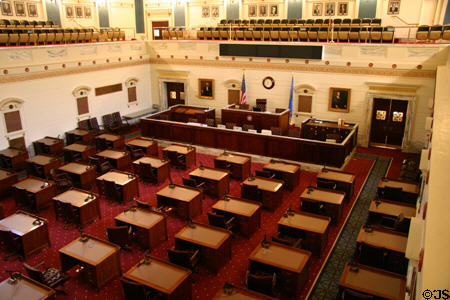
Since we couldn't get into the Senate Gallery, the image of the Senate Chamber at the left will have to do. During the restoration, three pieces of the stained glass skylight panels were found in the chamber attic and the Indiana firm which made them still had the 1917 work order and was able to repair and replicate the colorful glasswork. Light now filters in through windows which were sealed in the '30s, then hidden by later construction. The sealing was prompted, acccording to one story, by the actions of an overeager reporter who climbed onto the roof outside the chamber to eavesdrop on the proceedings. Onamental plasterwork has been meticulously cleaned, repaired and repainted and appropriate fixtures installed.
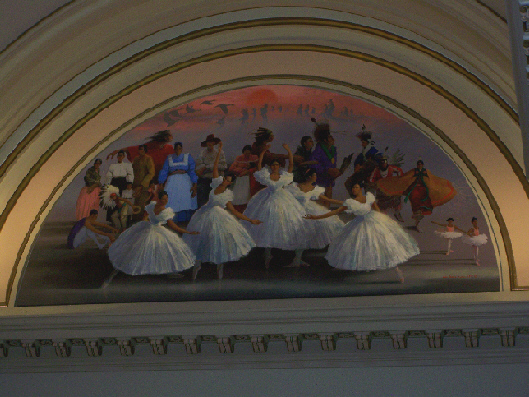
We are now in the middle of the north hall, and from here we could get a great view of one of the most beloved works of art in the Capitol,
"Flight of Spirit"
by Mike Larsen, a native Chickasaw. This painting (see my view of it at right) celebrates five world-famous Oklahoma Indian prima ballerinas: Yvonne choteau, Cherokee; Rosella Hightower, Choctaw; Moscelyne Larkin, Shawnee-Peoria; and Osage sisters Maria and Marjorie Tallchief. This painting is a fantasy scene, as the five women never danced together. The first time they appeared in public as a group was for the dedication of this painting in 1991. Steve was also able to get a good close-up of this painting, and you can see that close-up view
here.
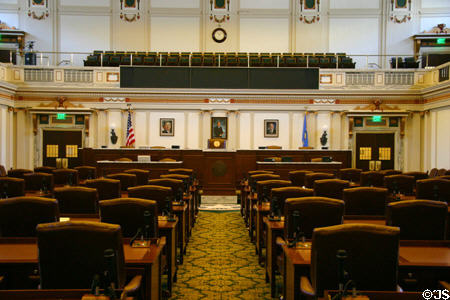
Again, since the House Gallery wasn't open, I've had to use the official picture shown at left to give you an idea of what the chamber was like. From my memory of being in the Texas House, this chamber is much more beautiful.

On this floor, you can walk out more into the middle of the building, although the atrium is still open three more floors down. (The third floor does not have access to the central core; just like the fifth floor, it is a hallway that runs around the perimeter of the building, directly underneath the fifth floor one. The second floor is like this one, allowing access further into the center of the building, and the first floor is continuous all the way across.) In this picture that Steve took
looking from the fourth floor down to the first,
you can see the second floor level balcony and all the way down to
the Great Seal of the State of Oklahoma
which is inlaid into the marble floor of the first level.
When we arrived on the fourth floor, we turned east to the head of the
Grand Staircase.
Here in the area of the staircase, we found many different colors of marble. The 52 steps (and most of the floors in the building) are alabama marble. The walls of the staircase are made of marble from Henryetta, while the darker, streaky marble around the top of the staircase and the banisters is Vermont marble. The two plaques on the staircase walls are black granite from Cold Springs, Oklahoma.
While the fifth floor consists of four hallways along each side of the open rotunda of the Capitol, the fourth floor allows one to get out into its middle, so we turned around and entered this rotunda for great views of
the interior of the dome.
In that picture, you can see a narrow purple ring above the large murals (more about those later). Everything above that ring is new construction.

All of us took a number of pictures looking up at the inside of the dome, and these pictures were taken at various angles from around the center of the rotunda on this level. Because the center of the rotunda floor is open here on the fourth floor, we could not get straight-up views; click on the thumbnails at left to see some of the best of the pictures we took of the dome here on the fourth floor.

Even though we did not get the straight up pictures of the dome interior until we got to the first floor, I am going to go ahead and include those pictures here. In the thumbnail images at right, the ones at either end were shots taken by Fred looking up at the dome. The middle three, taken by Steve, form a series, left to right, of successively closer and closer zooms to the State Seal at the center of the top of the dome. Click on these thumbnails to view the full-size pictures.
Below the dome, at the top of the pediments between the archways that lead east to the Senate Chamber, south to the Grand Staircase, west to the House Chamber and north to the administrative wing are four large murals highlighting eras in Oklahoma history. These murals were painted by artist Charles Banks Wilson. Before we take a look at these four murals, I'd like you to watch a movie that I made from here on the fourth floor of the interior of the Rotunda. The movie will begin by looking up at the dome, and then pan down and around the Rotunda to pull in the four murals. Then I will pan further down to show you the entire fourth floor and much of the artwork on the walls. I hope you will take a couple of minutes to watch that movie using the movie player at left.

The fourth floor is the display area for a great deal of beautiful artwork. To begin with, each of the archway supports around the Rotunda displays a life-sized portrait of an influential Oklahoman; all of these were painted by Oklahoma artist
Charles Banks Wilson.
We began at the southwest pillar with the painting of
Robert S. Kerr.
Kerr, Oklahoma's 12th governor- the first to be born on what would become Oklahoma soil- was also a U.S. Senator, the man behind Kerr-McGee Oil Industries and the McClellan-Kerr Waterway. (You can see my picture of the Kerr painting
here.)
In the next archway to the right, is a portrait of
Carl Albert,
former Speaker of the U.S. House of Representatives, and on the next archway is the portrait of
Dr. Angie Debo,
considered Oklahoma's foremost historian. On the final archway support, we could see Wilson's portrait of
Sequoyah,
who created the Cherokee syllabary, thereby preserving the phonetic language of his tribe for future generations. (You can have a look at my picture of this painting if you will click
here.)
It is believed he is the only person to invent an alphabet single-handedly. All four of these portraits were quite striking, particularly since they were life-sized.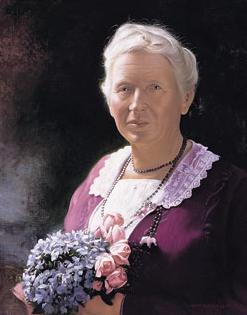
Miss Alice Robertson
In the
north arch entry
and on the wall across the hall we found paintings of three Oklahoma women influential in government.
All three of these paintings were done by artist
Mike Wimmer,
of Norman.
Miss Alice Robertson
was the second woman elected to the U.S. House of Representatives, the first from Oklahoma.
Representative Bessie McColgin
was the first female member of the Oklahoma House of Representatives (you can have a look at my picture of this painting if you will click
here)
and
Mrs. Lamar Looney
was Oklahoma's first female State Senator.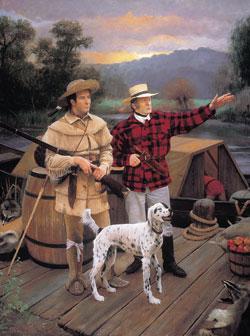
Nathaniel Pryor and
Sam Houston at Three Forks
Next, we walked through East Archway to the Senate Lobby. There were four paintings here, all by
Mike Wimmer.
These paintings were: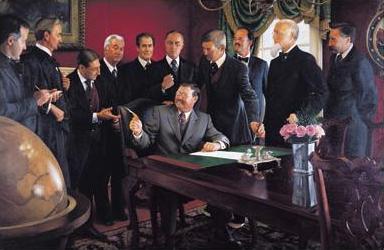
President Teddy Roosevelt
Signing Statehood Proclamation
Now we followed the guidebook's advice and walked around the 4th floor again, this time using the outer hall. North of the Senate Lobby we found
"President Teddy Roosevelt Signing Statehood Proclamation",
another work by
Mike Wimmer.
It depicts the moment that Oklahoma was declared the forty-sixth state in the Union. This was one of the few close-up shots I took of the various paintings that actually turned out halfway decent; you can have a look at it
here.
In the northeast corner of this same hall is one of the four portraits- the other three are in the other corners on this floor- of prominent African-American Oklahomans, all painted by
Simmie Knox.
"Edward P. McCabe 1850‑1923",
of Tulsa, founded the all-black town of Langston and served as deputy auditor of the Oklahoma Territory until statehood. Our picture of this painting was one of those that turned out OK, and you can see it
here.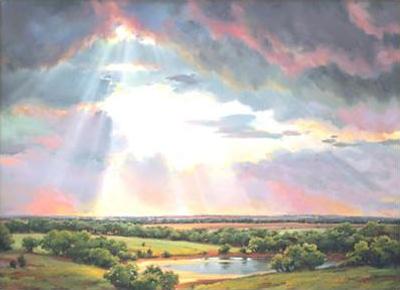
Showers of Sunshine
South of the Lobby is another Linda Tuma Robertson landscape. This one is entitled
"Showers of Sunshine, a Landscape of Grady County, Oklahoma".
Also here in the southwest corner of the floor was another of the series by Simmie Knox of prominent African-American Oklahomans, this one portraying
"Benjamin Harrison Hill 1904‑1971,"
a civic leader and pastor who was elected to the Oklahoma House of Representatives in 1968.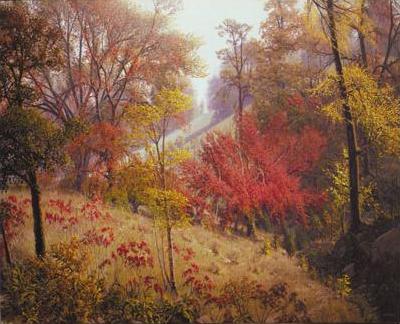
"Autumn Woods North of Tahlequah"
The most striking artwork on this floor are the four large paintings displayed in the rotunda on the walls between the four archways that lead east, north, west and south. These paintings are called, collectively, "Visions of the Land - The Centennial Suite." They were painted by Tulsa-born artist
Wilson Hurley.
Their locations in the rotunda echo the areas they represent; being in the center of the state, the paintings of the four scenes, which exist northeast, northwest, southwest and southeast of the capitol building, could be placed at those same compass positions in the rotunda. The small Oklahoma town of Tahlequah is about forty miles east of Tulsa, and both towns are northeast of Oklahoma City. So Hurley's painting entitled
"Autumn Woods North of Tahlequah"
is mounted between the north and east archways.

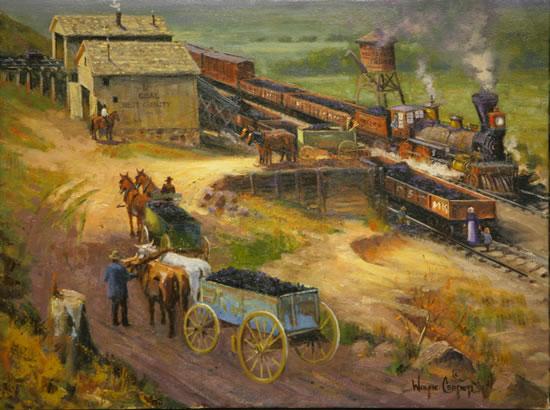
"First Coal Production at McAlester and the KATY Railroad"
The seal on display has been a source of controversy for decades. The Territorial Capital of Oklahoma and the first capital of the state was Guthrie. A vote to determine the permanent capital was scheduled for 1913. Politics and economics intervened and, by a vote of the people on June 11, 1910, Oklahoma City won the honor. The election was held on a Saturday, making it hard for opposition to see legal recorse. By early Sunday morning, Governor Haskell and the official state seal, which had been removed (some say, stolen) from Guthrie were in Oklahoma City. On hotel stationery, the governor wrote a proclamation declaring Oklahoma City as the capital and imprinted it with the seal. The capital has been there ever since.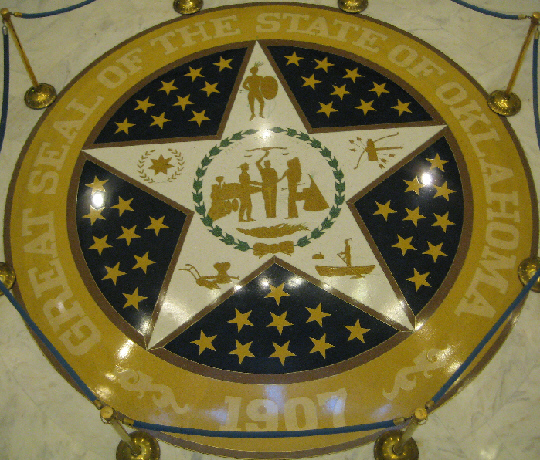
In the center of the floor was the replica of the Great Seal of the State of Oklahoma. Each ray of the seal's five pointed star represents one of the Five Civilized Tribes. The top ray is the Chickasaw Nation seal. Clockwise are the seals of the Choctaw Nation, Seminole Nation, Creek Nation and Cherokee Nation. Oklahoma's state motto, "Labor Conquers All," is inscribed in Latin at the top of the Territorial seal within the green wreath. In the center of the star, figures symbolizing Oklahoma Territory and Indian Territory are shown joining together to become the state of Oklahoma. Standing right next to the great seal, Fred got a final, excellent view looking all the way up through all five floors to the top of the inside of the dome. His picture shows all the levels and all the ornamentation, and you can have a look at that picture
here.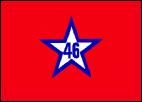
The first Oklahoma State Flag adopted in 1911 was a simple affair, its color pallette modeled after the red, white and blue of the Stars and Stripes. The 1911 flag displayed a white star, edged in blue, centered on a field of red. Inside the star, the number "46" was shown; reference to Oklahoma as the 46th state to enter the union in 1907.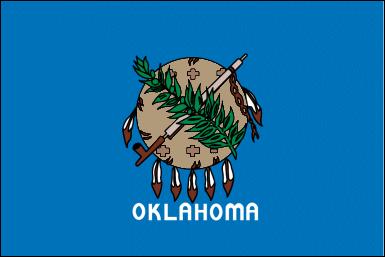
The 1925 flag, essentially the same as today's state flag, prominently displays an Osage warrior's shield made from buffalo hide and decorated with seven eagle feathers hanging from the lower edge. The shield is centered on a field of blue borrowed from the blue flag that Choctaw soldiers carried during the Civil War. This flag honors more than 60 groups of Native Americans and their ancestors. The shield is decorated with six white crosses (stars) representing high ideals. Superimposed over the shield are symbols of peace and unity from the cultures of the Native American and European-American settlers in the territory; the calumet or ceremonial peace pipe and the olive branch.
We ended our tour of the Oklahoma State Capitol Building with a visit to the West Gallery. Here, the Oklahoma Arts Council presents works from the Oklahoma State Art Collection, a visual anthology of the history of artistic expression in Oklahoma. You can walk into the State Art Collection with me if you will use the player at right to have a look at the movie I made.


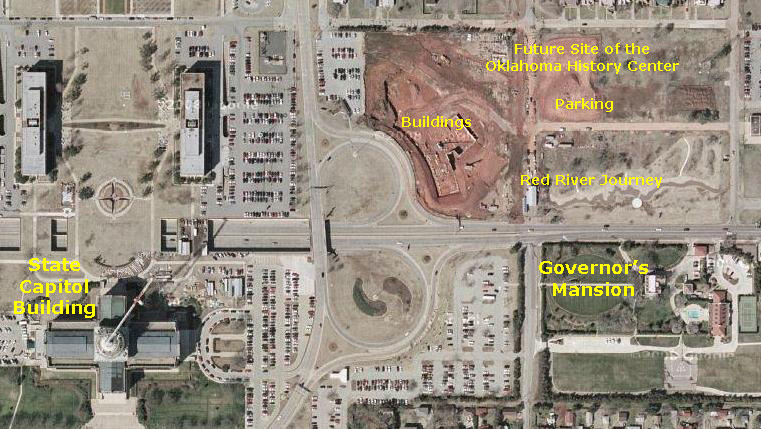
An Aerial View of the Capitol/History Center Area
When we left the State Capitol, we drove a short distance- just a few blocks- northeast to the brand new Oklahoma History Center. The museum complex is so new, that when I went to Google maps to grab an aerial view, all I got was what you see at left. The History Center opened in 2005, so that dates the aerial views of this part of Oklahoma City, at least, to sometime in 2004. You can make out the footprint of the eventual buildings (see diagrams below), the outlines of the "Red River Journey," and the parking area and future location of the oil industry outdoor exhibits.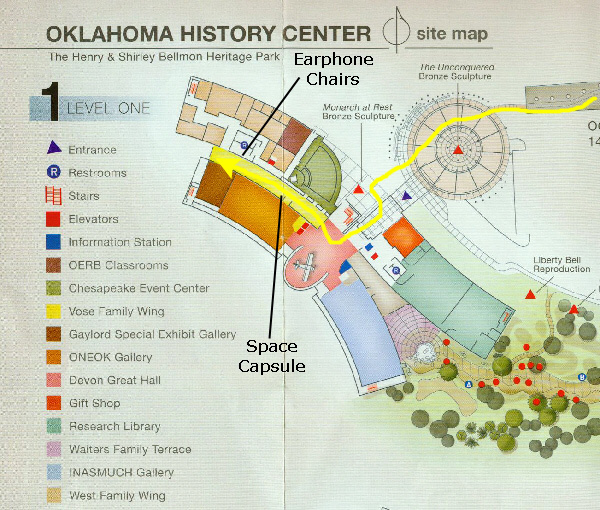
We parked the car out near the outdoor exhibition of oil wells and equipment- the
Devon Energy Oil and Gas Park.
It was quite warm, so we just walked by the exhibition and on towards the museum entrance. Between the energy display and the museum was the OGE Energy Corp. "14 Flags Over Oklahoma" (which I took to be a bit of a dig at Texas, which has only flown six flags). You can see some of these flags in the last picture. Most of the Oklahoma flags were never actually used anywhere in the state; it is assumed that as bits and pieces of the territory were traded back and forth between France, Britain and Spain, that the national flags of those countries would, technically, have been flown had there been anyone in Oklahoma to fly them. Texas could have laid claim to almost all of the Oklahoma flags, too, but I guess we aren't so starved for notoriety that we have to list them all. If you are curious as to just what all these flags were, here is the list of
Oklahoma's 14 Flags.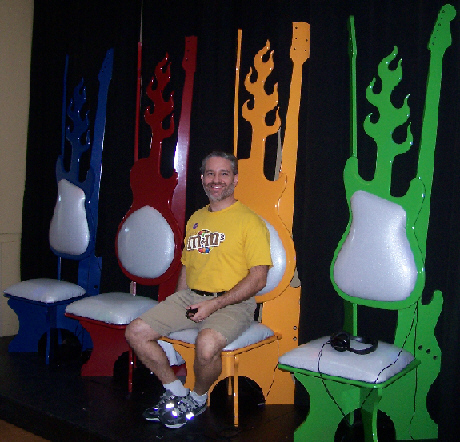
I might also mention that on the third level in the atrium there were a number of sculptures by Oklahoma artists outside the Winnie Mae Cafe, and you can have a look at two of them
here
and
here.
We weren't going to go through the museum in any particular sequence, so we began by walking down the hall past the space capsule towards the Gaylord Special Exhibit Gallery. Just before we reached its entrance, we ran across one of the more interesting features of the History Center (see the inset picture). These
custom chairs
were created by Hugh Meade of Oklahoma City. Using the headphones provided at each chair, we could sit and listen. What we heard were the top 10 songs voted on by the people of Oklahoma during the section for the state's official Rock song. In the interest of leaving no stone unturned in this album, I might tell you that on April 28, 2009 Governor Brad Henry signed an executive order naming "Do You Realize??" by the Flaming Lips the Official Rock Song of Oklahoma. Governor Henry stated “Oklahomans spoke loud and clear in that vote, and I thought it was important to make sure their choice was heard. Not only are the Flaming Lips among the most original bands in rock music, they are great ambassadors for Oklahoma. They are fiercely loyal and proud Oklahomans, and their fellow Oklahomans are evidently just as loyal and proud about this Oklahoma born-and-bred group." The Governor went on to proclaim April 28, 2009 "Flaming Lips Day" in Oklahoma. Great.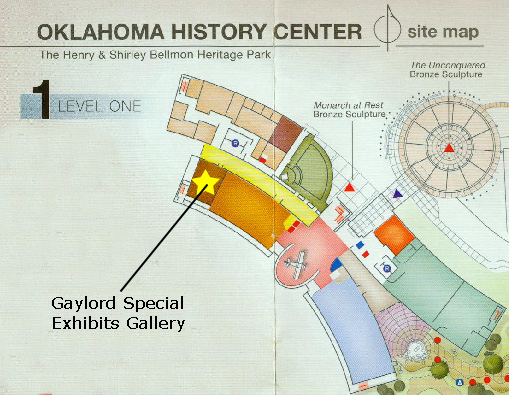
The Gaylord Special Exhibits Gallery hosts revolving exhibits that herald Oklahoma's citizens and or history. Some of these special exhibits may feature all or parts of a single collection, while other may bring together items from two or more collections to tell a story. This gallery also hosts traveling exhibits from other museums located here and abroad.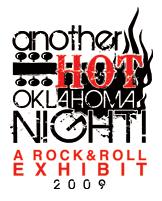
Today, this gallery is host to an exhibit entitled "Another Hot Oklahoma Night: A Rock & Roll Exhibit." This exhibit explores the Rock and Roll artists, radio stations, personalities, venues, and fans that have called Oklahoma home. Beyond the facts of each story, the exhibit shows how growing up in Oklahoma affected the music. I'll admit to not being much of a music buff, and so most of the bands and performers showcased in the exhibits were quite unknown to me. Mario, on the other hand, was a font of useful information and commentary, the music scene being his "thing."

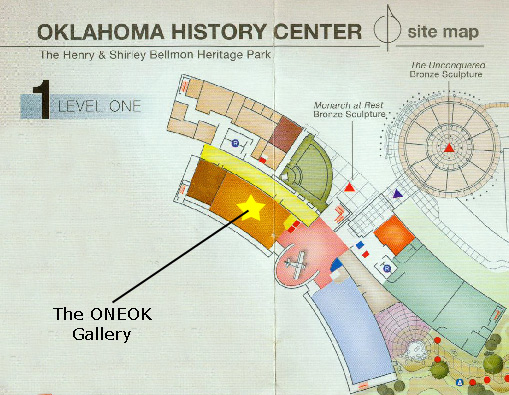
Representing all 39 American Indian tribes currently associated with Oklahoma, the ONEOK Gallery (I believe the Gallery name is a shortened form of "One Oklahoma") offers visitors the opportunity to explore the traditional historic past of the native peoples of Oklahoma as well as experience contemporary Indian cultures. Using the American Indian experience as a bridge between the past and the present, the exhibit offers artifacts, tribal music, photographic images, Indian art and oral histories from the Indian tribes of Oklahoma.

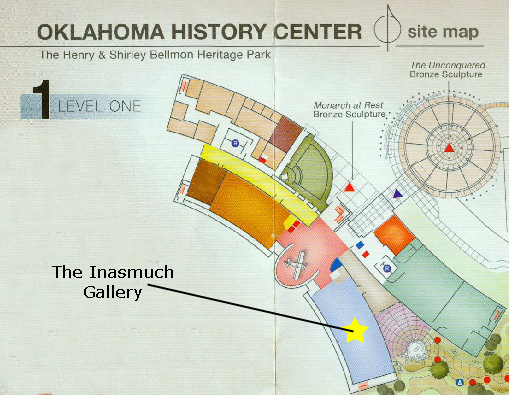
"Inasmuch as ye have done it unto one of the least of these, my brethren, ye have done it unto me." It was this quote from the Bible that Edith Kinney Gaylord used to name the foundation that she established; she thought it would embody the idea of an institution created to aid in the betterment of her community- which meant Oklahoma. Gaylord was the daughter of the publisher of the two primary newspapers in Oklahoma; her father's name is on another of the galleries at the Oklahoma History Center. Edith had a career in journalism, reporting nationally and internationally for the AP, and locally for her family's newspapers and, later, radio and television stations. Heiress to a large fortune, but independent enough to enlarge it significantly on her own, she endowed the Inasmuch Foundation before her death in 2001 at age 84.

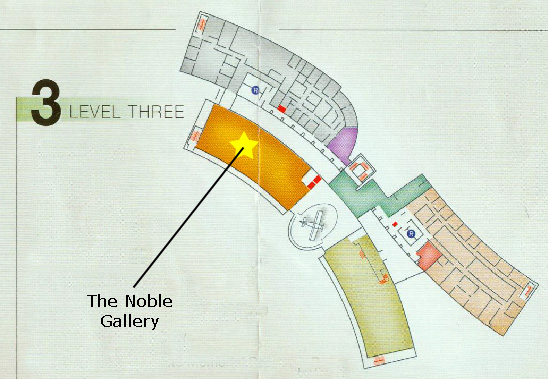
In 1921, at the age of 24, Lloyd Noble borrowed $15,000 from his mother to buy his first oil drilling rig. From this initial purchase, he became one of the most successful and respected onshore drilling contractors in the United States- founding Noble Corporation and Noble Energy, both traded on the NYSE. Mr. Noble often spoke of the privilege he enjoyed to live in a country where the spirit of entrepreneurship and freedom of enterprise were encouraged. Consequently, he had a strong commitment to give back to the society that he felt had afforded him opportunities for personal and financial success. As evidence of this commitment, he created The Samuel Roberts Noble Foundation, Inc., in 1945. He named the Foundation after his father, who he said was the most generous man he had ever known.
I found the gallery immensely interesting; so much so that I completely forgot about taking pictures- until I came to an area of the hall that covered fashions and home life in the 1950s and 1960s. One small exhibit, believe it or not, was devoted to hair styles of the era, and one of the items in the exhibit seemed to be an extract from a local high school yearbook. From today's perspective, the kids looked really funny, but I'll let you be the judge. Take a look at a couple of pages from this yearbook
here
and
here.
And use the movie player at right to have a look at the short movie I made of a few other pages; I am sure you will see some people you once knew.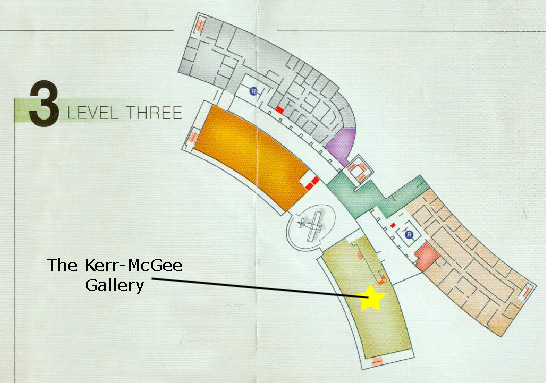
Endowed by the Kerr-McGee Corporation, this gallery is a rich history of Oklahoma from its military contributions since the first expeditions by the Spanish in the 16th century, to its oil and gas exploration. there are numerous artifacts recovered from an 1830s riverboat recently excavated from the Red River, examples of Oklahoma's entrepreneurial history, and a 3-D reconstruction of an oil derrick.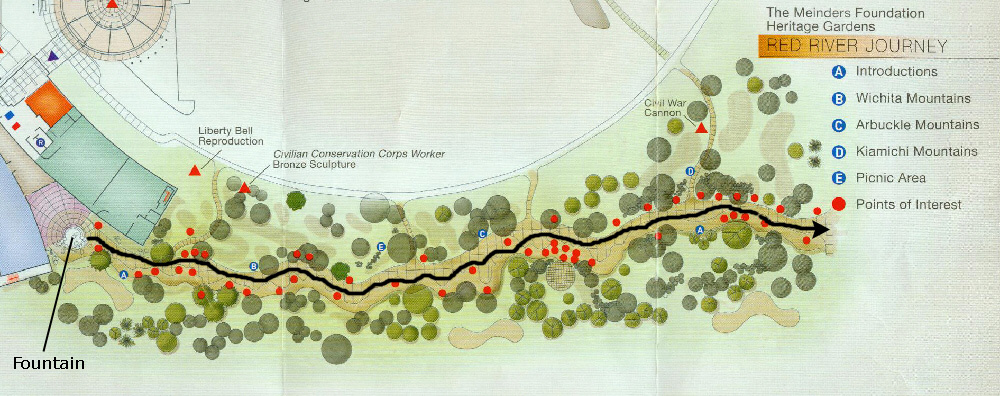
Diagram of the Red River Journey at the Oklahoma History Center

At the opposite
end of the trail
we encountered a sculpture the name of which I did not record. What was interesting about it (you can see it in the previous picture) was that the base was wrapped by a thin steel sheet into which a repeating pattern of buffalo had been cut. We found this an extremely interesting use of art, not just because of the buffalo theme. Fred took a few pictures of the steel enclosure from different angles, and you can see these pictures if you click on the thumbnail images at right.
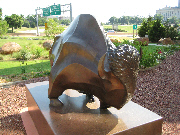
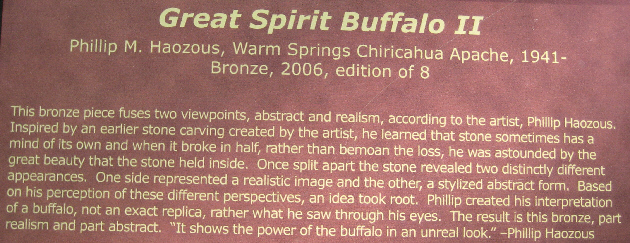
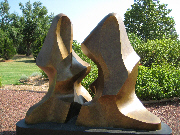
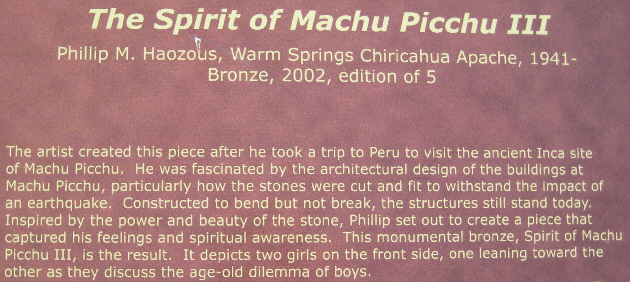
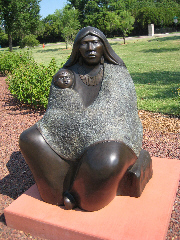
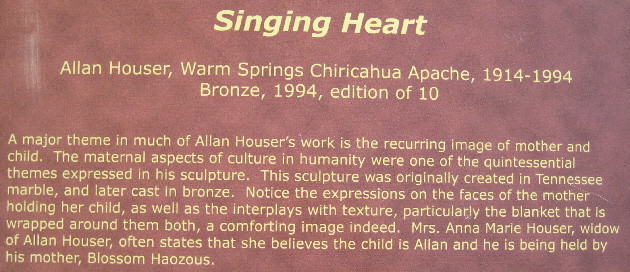
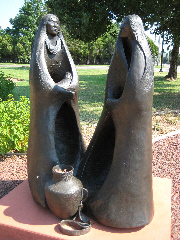
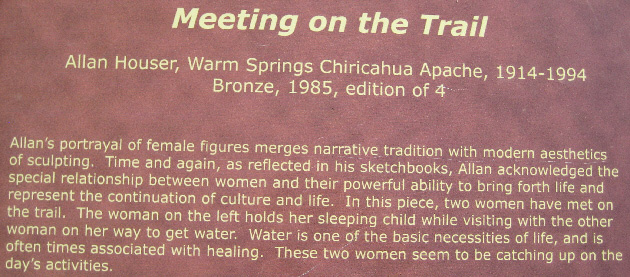
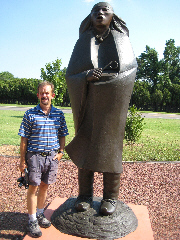
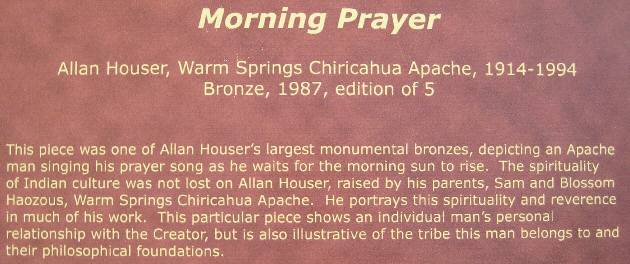
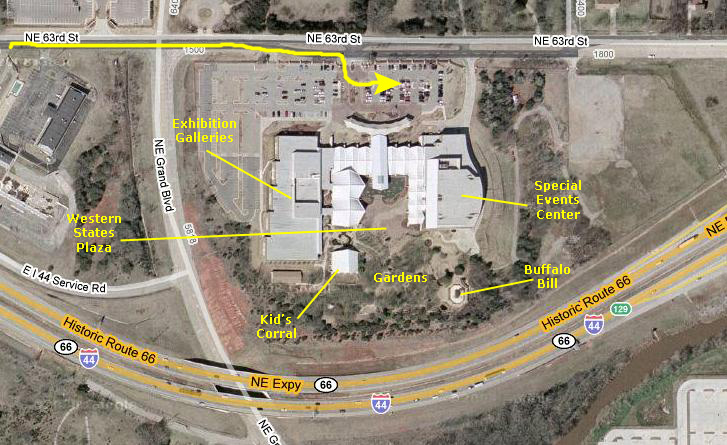
An Aerial View of the National Cowboy Museum
Getting to the museum was a pretty easy drive, and we arrived there around eleven in the morning.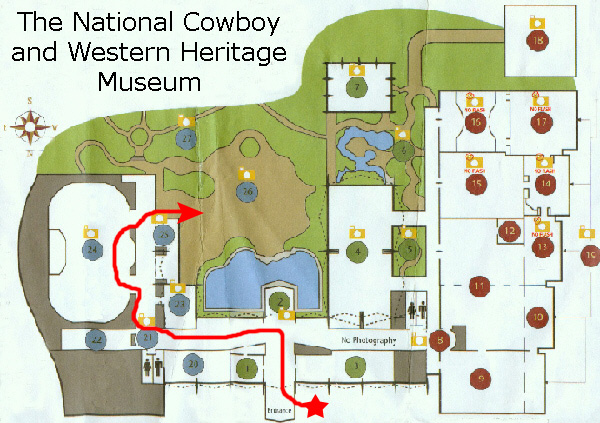
Diagram of the National Cowboy Museum
To begin with, then, you can look at the diagram from the museum brochure at right. (When you do, I should point out that the Museum, probably in an effort to arrange a pleasing layout for their brochure, fitted the lower right corner of the diagram into the lower right corner of the brochure. This allowed them to flow text around the curved edge of the green area representing the gardens. Unfortunately, it also had the effect of flipping the compass, so that north is at the bottom and west is at the right. And here I had thought that arranging maps and diagrams so that north was always at the top and west always at the left had become so standard that this kind of idiocy would have been stamped out. I can only hope that the restaurant loses a lot of business when people tell each other that it's in the west wing of the museum, as would be natural from glancing at the diagram. I might also hope that the museum docents are contstantly pointing out that the compass has been flipped.)
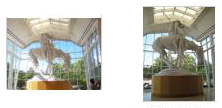
You might want to see a couple more views of this amazing sculpture; just click on the thumbnails at left.

Turning left, we could look down the broad hallway past the theatre and the seating areas and the sculpture of John Wayne towards James Earle Fraser's sculpted portrayal (#21) of
President Lincoln,
sitting in quiet meditation during the early days of the Civil War. His sculpture is here because he made remarkable contributions to the settlement of the West. At right are a few thumbnail images for some pictures of this area; click on them to have a look.

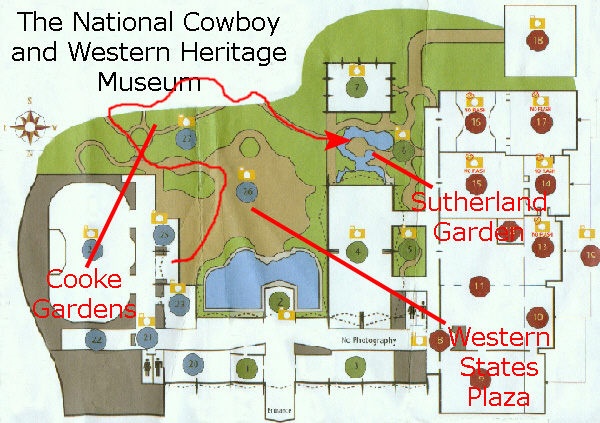
A Walk Through the Plaza and Gardens
From the
Western States Plaza,
I turned southeast into the Jack and Phoebe Cooke Gardens. I could see that the gardens covered at least a couple of acres, and from the guide brochure I knew that there would be sculptures and other points of interest along the winding flagstone walkways. Just looking at the expanse from the plaza- the cool green grass and trees,
native plantings
and winding artificial streams- was invitation enough to spend some time here.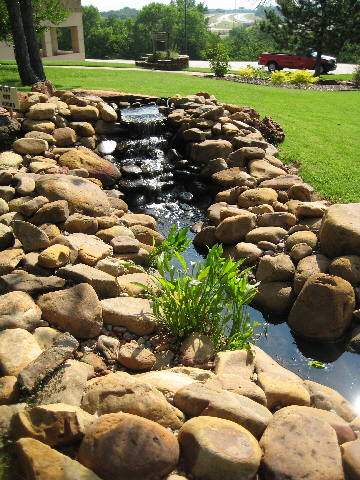
One aspect of the gardens that I found most refreshing was the use of water features. From the Western States Plaza and the Norma Sutherland Garden, the Cooke Gardens slope gently down towards the southeast, and the museum landscapers have put in three artificial "springs" near the top of the slope. Then they have built rock-lined streams that flow naturally downhill through the area. A couple of them end up at a pool near the Buffalo Bill sculpture, and another ends at a different pool. Then the water is pumped back to the top. It has all been done very well. I took quite a few movies of these water features, and I have picked three of the best ones to include here. You can watch them using the three movie players below:
Easternmost Spring and Watercourse
to the Buffalo Bill Sculpture
Spring Near the Sutherland Garden and Watercourse to the Southeast
Stream from the Sutherland Garden Flows Under the Walkway and to the Buffalo Bill Sculpture

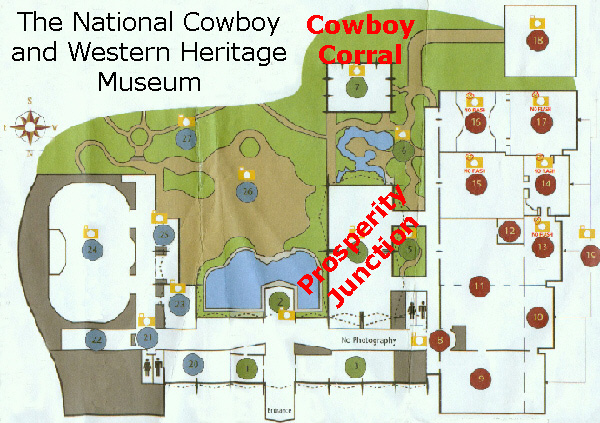
I took a quick walk next through the Children's Cowboy Corral which, as its name implies, is an interactive area for kids. Unlike other areas of the museum, here they are encouraged to touch and play; they can dress up like cowboys, learn about ranch life and pretend they're in a real bunkhouse, surrounded by mountain terrain. Oddly enough, this gallery also contained the largest
buffalo sculpture
that I saw anywhere in the museum. You may be interested in some of the pictures I took here; if so, just click on the thumbnail images below to have a look at them:


(The Robert and Nedra Funk Western Town Gallery)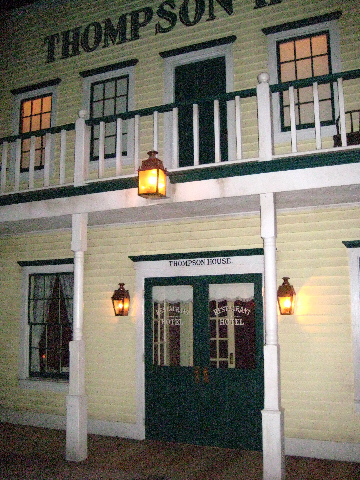
"Welcome to Prosperity Junction," the signs at either end of "town" read. "Our community is a small, twenty-year-old cattle town located somewhere in the West at the turn of the century. The railroad, which arrived only a few years ago, has wrought many changes in our community. Factory-made building materials, luxury household goods, and visitors from outside the region, all brought by the railroad, have transformed Prosperity Junction from a raw frontier cattle town to a growing, prosperous community on the eve of the twentieth century."


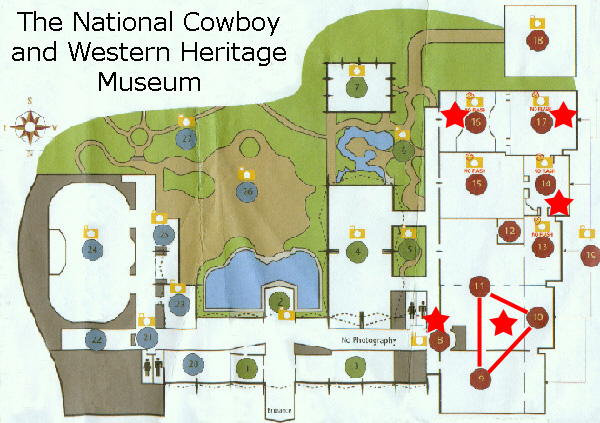
Now we took some time to walk through the various galleries in the exhibition wing of the museum. We walked through all of them, but took pictures only in some of them. Some galleries were off-limits to photography (although I snuck a couple of photos of some paintings featuring buffalo), while others didn't allow flash photography. For this reason, quite a few of the pictures we tried to take didn't really turn out, but we got enough good shots to give you an idea of what the various galleries were like. Where I've included pictures here, I've marked the diagram with a red star. We began at the main entrance to the wing, which was right at the end of Prosperity Junction.
The Arthur and Shifra Silberman Gallery of Native American Art (#10)
The William S. and Ann Atherton Art of the American West Gallery (#11)
The next three galleries were mostly painting and sculpture. The Kerr Gallery houses rotating exhibitions from other galleries, including Prix de West; the Silberman Gallery houses a rotating display of fine art from the Museum's collection, all of it emphasizing an aspect of Native American art; the Atherton Gallery displays collection art emphasizing all aspects of the American West, and includes works by Russell, Remington, Bierstadt and Leigh. Photography was not allowedin these galleries, but this didn't stop me from taking two pictures of buffalo art and a (slightly fuzzy) picture of an interesting horse sculpture. You can have a look at these pictures by clicking on the thumbnail images below:

Honoring Western performers who have contributed to the making and preservation of the stories and legends of the West, this gallery features the Museum's extensive collection of memorabilia, including the John Wayne collection of personal firearms, kachinas and artwork. Many of the displays focused on specific movies or television shows, as you can see from the posters in the displays that I took pictures of. Click on the two thumbnails below to see these pictures.
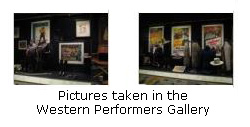
Set in a lifelike 1950s arena, this gallery showcases artifacts of rodeos, including history, champions, clothing, equipment and memorabilia. You can almost taste the dust (the museum's words, not mine) as you revisit the gritty, exciting and dangerous lives of rodeo heroes. There was an interesting computer kiosk that offered details of inductees to the Rodeo Hall of Fame. Fred and I took a couple of pictures that turned out well, and you can look at them by clicking on the thumbnails below.
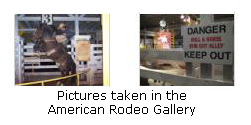
Again, my movie seemed to do a better job of capturing the feel of the gallery, and you can watch it using the movie player at right.

In this gallery, you could learn about the military in the West, hunting on the frontier, mountain men and Native Americans in a lively presentation on the history of the West. This collection was amassed by Joe Grandee, a Western illustrator who used these artifacts to translate authentic details to his narrative paintings.

July 6, 2009: The Paul Potts Concert in Dallas

June 17-21, 2009: A Trip to New Mexico

Return to Index for 2009